Recent Fire Damage Posts
The Fire Damage Restoration Steps that Save Middleton Real Estate
4/5/2025 (Permalink)
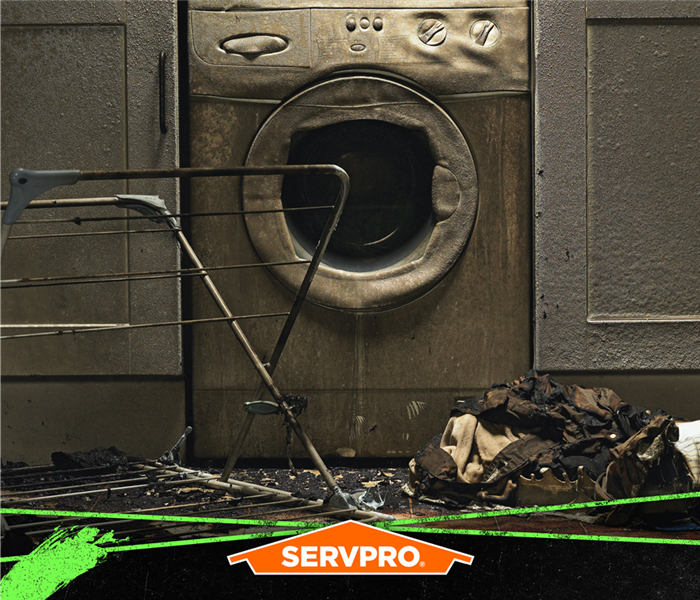 When your MIddleton home has a fire-damaging meltdown--Call SERVPRO to restore your property and your peace of mind. Here to Help®
When your MIddleton home has a fire-damaging meltdown--Call SERVPRO to restore your property and your peace of mind. Here to Help®
Standard Work Controls Post-Fire Recovery Costs
Projects and other activities with directions are easy to follow, and fire damage restoration work is no exception. After a fire in your Middleton property, call SERVPRO® for restoration services that adhere to the IICRC's high standards.
SERVPRO provides fire damage restoration services to Middleton homeowners, ensuring their home's post-fire condition is short-lived. Our goal is to produce surprising and cost-effective results, leaving your property "Like it never even happened." Because fire acts similarly within modern homes, standardized procedures from the IICRC ensure we use proven methods.
Here are some of the restoration methods for fire damage outlined by the IICRC:
- Soot removal techniques
- Water removal's importance
We use wet and dry removal methods, according to IICRC recommendations. We would use a wet process with a degreaser for oily soot on smooth surfaces. When we need to eliminate dry soot, we lean toward using a brush and vacuum - excellent for almost all surfaces. Sticky soot on upholstery requires a different approach. We remove as much of the soot as possible using a dry method. Then, we use sponges to absorb soot, drawing it away from the fibers. Afterward, we use a wet process that dissolves the remaining soot, making it easier to wash it away.
Many homes also experience water damage because of the water used to fight fires. SERVPRO can help protect your home from this while performing fire damage restoration. We use extraction equipment of many kinds to prevent dry rot, high humidity, and mold infestations. Avoiding such issues is less expensive than resolving them later.
Call the restoration experts at SERVPRO of Salem / Peabody / Marblehead at (978) 744-4545 after your family experiences a house fire. We are Faster to any size disaster™.
Understanding Fire Statistics and Why SERVPRO is Essential for Recovery
6/3/2024 (Permalink)
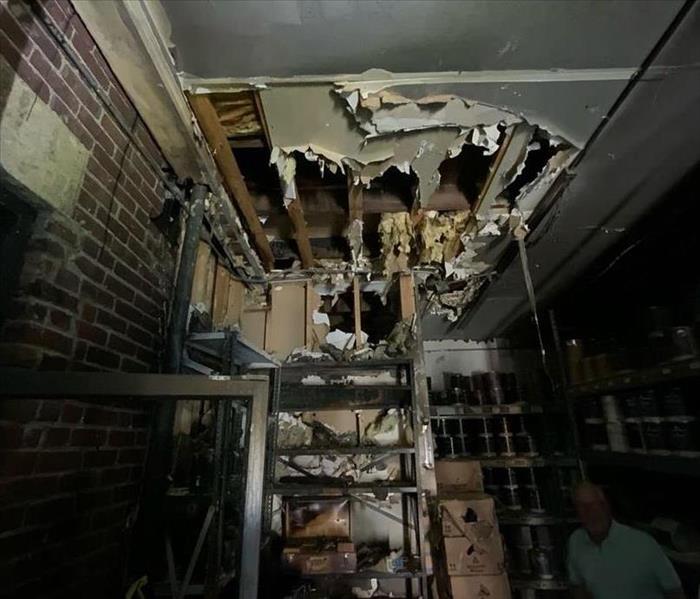 By offering prompt, expert assistance, SERVPRO plays a vital role in helping individuals and businesses rebound from the devastating effects of fires
By offering prompt, expert assistance, SERVPRO plays a vital role in helping individuals and businesses rebound from the devastating effects of fires
Fires can strike unexpectedly, causing devastating damage to homes and businesses alike. Understanding the statistics behind fires and their aftermath can shed light on the importance of professional restoration services like SERVPRO® in mitigating the damage and facilitating recovery.
Fire Statistics: A Stark Reality
Frequency: According to the National Fire Protection Association (NFPA), there were an estimated 1.3 million fires reported in the United States in 2019 alone, resulting in significant property damage and loss.
Property Damage: The aftermath of a fire can be financially crippling. In 2019, direct property damage caused by fires amounted to over $14.8 billion in the U.S. This includes damage to structures, belongings, and other assets.
Impact on Families and Businesses: Beyond the financial toll, fires have a profound emotional and psychological impact on those affected. Families lose homes filled with memories, while businesses face disruptions that can lead to financial instability.
Recovery Challenges: Recovering from a fire is a complex and arduous process. From smoke and soot damage to structural issues, the aftermath of a fire requires comprehensive restoration efforts to restore affected properties to their pre-fire condition.
The Importance of SERVPRO® in Fire Recovery
Immediate Response: SERVPRO understands the urgency of fire damage restoration. With a 24/7 emergency response, they are equipped to spring into action swiftly, minimizing further damage and beginning the restoration process promptly.
Expertise and Experience: Fire damage restoration requires specialized knowledge and skills. SERVPRO technicians undergo rigorous training and certification to handle all aspects of fire restoration, from smoke odor removal to structural repairs.
Advanced Technology and Equipment: SERVPRO utilizes state-of-the-art equipment and advanced techniques to ensure thorough and efficient fire damage restoration. From air scrubbers to thermal foggers, their arsenal of tools enables them to tackle even the most challenging restoration projects.
Comprehensive Services: Beyond fire damage restoration, SERVPRO offers a range of services to expedite the recovery process. This includes water damage restoration, mold remediation, and even reconstruction services, providing a one-stop solution for all post-fire restoration needs.
Insurance Liaison: Dealing with insurance companies can be overwhelming, especially in the aftermath of a fire. SERVPRO works closely with insurance providers, facilitating the claims process and ensuring that clients receive the coverage they are entitled to.
In conclusion, the statistics surrounding fires underscore the critical need for professional restoration services like SERVPRO. By offering prompt, expert assistance, SERVPRO plays a vital role in helping individuals and businesses rebound from the devastating effects of fires, restoring hope and rebuilding lives in the process.
Battling Soot and Smoke: Tips for Effective Cleanup
5/20/2024 (Permalink)
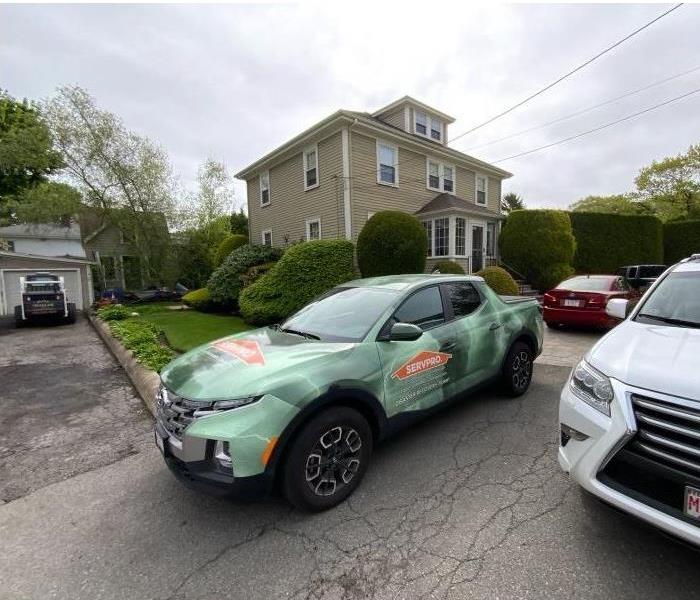 If you encounter challenges or require assistance, don't hesitate to reach out to professional restoration services like SERVPRO for expert help!
If you encounter challenges or require assistance, don't hesitate to reach out to professional restoration services like SERVPRO for expert help!
Dealing with the aftermath of a fire can be overwhelming, especially when it comes to cleaning up soot and smoke damage. Soot particles can penetrate surfaces and linger in the air, while the odor of smoke can be persistent and difficult to eliminate. However, with the right approach and professional assistance, it's possible to effectively tackle these challenges and restore your property to its pre-fire condition. In this blog post, we'll discuss some tips for battling soot and smoke damage.
Safety First: Before beginning the cleanup process, it's crucial to prioritize safety. Wear appropriate protective gear such as gloves, goggles, and a mask to avoid exposure to harmful particles and chemicals. Ensure that the area is well-ventilated to prevent inhalation of toxic fumes.
Assess the Damage: Start by assessing the extent of the soot and smoke damage throughout your property. Take note of affected areas, including walls, ceilings, furniture, and personal belongings. This will help you develop a comprehensive cleanup plan and determine whether professional assistance is necessary.
Ventilation and Air Purification: Proper ventilation is essential for removing smoke odor and improving air quality. Open windows and doors to allow fresh air to circulate throughout the space. Additionally, consider using air purifiers equipped with HEPA filters to capture airborne soot particles and neutralize odors.
Clean Surfaces and Belongings: Use appropriate cleaning techniques and products to remove soot residue from surfaces and belongings. For non-porous surfaces, such as metal or glass, a combination of soap and water or specialized cleaning solutions may be sufficient. However, porous materials like upholstery and fabric may require professional cleaning services to effectively remove soot and odor.
Address HVAC Systems: Smoke particles can infiltrate HVAC systems, spreading odor and contaminants throughout your property. It's essential to clean and inspect HVAC ducts, filters, and vents to prevent the recirculation of smoke-laden air. Consider hiring a professional HVAC technician to perform a thorough cleaning and maintenance service.
Consider Professional Restoration Services: In many cases, the cleanup and restoration of soot and smoke damage require specialized knowledge and equipment. Professional restoration companies, such as SERVPRO®, have the expertise and resources to handle even the most challenging cleanup tasks. They can utilize advanced techniques such as thermal fogging, ozone treatment, and media blasting to effectively remove soot and eliminate smoke odor.
Monitor for Lingering Odors: Even after thorough cleaning, smoke odor may persist in your property. Monitor the affected areas for lingering odors and take proactive steps to address them. Consider using odor-neutralizing products, such as activated charcoal or vinegar solutions, to absorb remaining odors and freshen the air.
Conclusion: Battling soot and smoke damage requires patience, diligence, and the right tools and techniques. By prioritizing safety, assessing the damage, and employing effective cleanup strategies, you can restore your property and create a safe and healthy environment for yourself and your loved ones. If you encounter challenges or require assistance, don't hesitate to reach out to professional restoration services like SERVPRO for expert help. With their expertise and experience, they can guide you through the cleanup process and ensure that your property is restored to its pre-fire condition.
Rising from the Ashes: Navigating Commercial Fire Restoration with SERVPRO®
5/2/2024 (Permalink)
 If your commercial property has been affected by a fire, don't hesitate to contact SERVPRO® for professional restoration services!
If your commercial property has been affected by a fire, don't hesitate to contact SERVPRO® for professional restoration services!
Commercial fires can be devastating, disrupting operations, damaging property, and posing significant challenges for businesses of all sizes. However, with the right expertise and approach, it's possible to restore affected properties efficiently and effectively. In this blog post, we'll explore the unique challenges faced in restoring commercial properties after a fire incident and the innovative solutions offered by SERVPRO.
Understanding the Scale:
- Commercial properties often have larger footprints and complex layouts compared to residential buildings, presenting unique challenges in assessing and mitigating fire damage.
- SERVPRO teams are trained to quickly evaluate the extent of damage, prioritize areas for restoration, and develop comprehensive action plans tailored to each commercial property.
Minimizing Downtime:
- Downtime can be costly for businesses, making swift restoration essential.
- SERVPRO utilizes advanced equipment, strategic planning, and round-the-clock service to minimize downtime and get businesses back up and running as soon as possible.
Specialized Techniques and Equipment:
- Commercial fire restoration often requires specialized techniques and equipment to address unique challenges such as smoke and soot removal from large spaces, HVAC systems, and sensitive electronic equipment.
- SERVPRO technicians are equipped with state-of-the-art tools and undergo extensive training to handle these challenges with precision and efficiency.
Compliance and Safety:
- Compliance with safety regulations and industry standards is paramount in commercial fire restoration.
- SERVPRO adheres to strict safety protocols and stays up-to-date with relevant regulations to ensure the safety of occupants and workers throughout the restoration process.
Communication and Coordination:
- Effective communication and coordination are essential when restoring commercial properties, especially in multi-tenant buildings or properties with multiple stakeholders.
- SERVPRO project managers act as liaisons between all parties involved, facilitating seamless communication and ensuring that everyone is informed and on the same page.
Insurance Guidance and Documentation:
- Navigating insurance claims and paperwork can be overwhelming for business owners dealing with the aftermath of a fire.
- SERVPRO experts are experienced in working with insurance companies, providing documentation, and advocating for clients to ensure they receive fair and timely compensation for their losses.
Conclusion: Restoring a commercial property after a fire requires a combination of expertise, resources, and dedication. With SERVPRO's specialized approach, businesses can overcome the unique challenges of fire damage and emerge stronger than ever. If your commercial property has been affected by a fire, don't hesitate to contact SERVPRO for professional restoration services tailored to your needs.
Fire Restoration Methodolgy
4/11/2023 (Permalink)
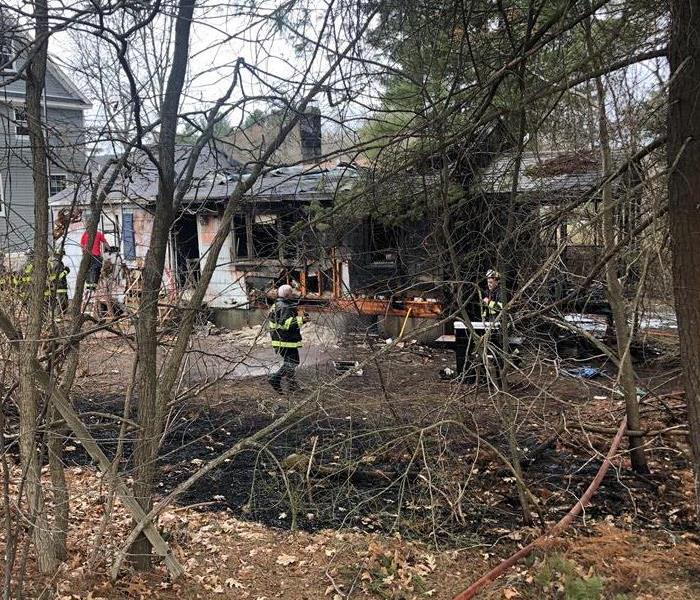 Destruction left behind.
Destruction left behind.
SERVPRO uses a thorough methodology for fire restoration to ensure that the affected property is restored to its pre-fire condition. Here is a general outline of their fire restoration process:
Emergency Contact: The restoration process starts with a call to SERVPRO's 24/7 emergency hotline. A representative will ask questions to determine the type of fire damage and the equipment and resources needed for the restoration process.
Inspection and Fire Damage Assessment: Their technicians will assess the extent of the fire damage, including the damage to the structure and contents of the property.
Board-Up and Roof-Tarp Services: If necessary, they will board up or tarp the property to protect it from further damage.
Water Removal and Drying: If there is water damage resulting from firefighting efforts, SERVPRO will remove the water and dry the property using dehumidifiers and air movers.
Smoke and Soot Removal: They will use specialized equipment and techniques to remove smoke and soot from all surfaces, including walls, ceilings, and floors.
Cleaning and Sanitizing: They will clean and sanitize all restorable items affected by the fire, using specialized cleaning products and techniques.
Restoration: Depending on the extent of the damage, they may repair or replace damaged structural materials or contents, such as flooring, walls, or furniture.
Throughout the process, SERVPRO will communicate with the property owner and insurance adjuster to keep them informed of the progress and any necessary changes to the restoration plan. The goal is to restore the property as quickly and efficiently as possible, while minimizing disruption to the property owner's life.
Removing Fire Damage from Surfaces in Salem
8/16/2022 (Permalink)
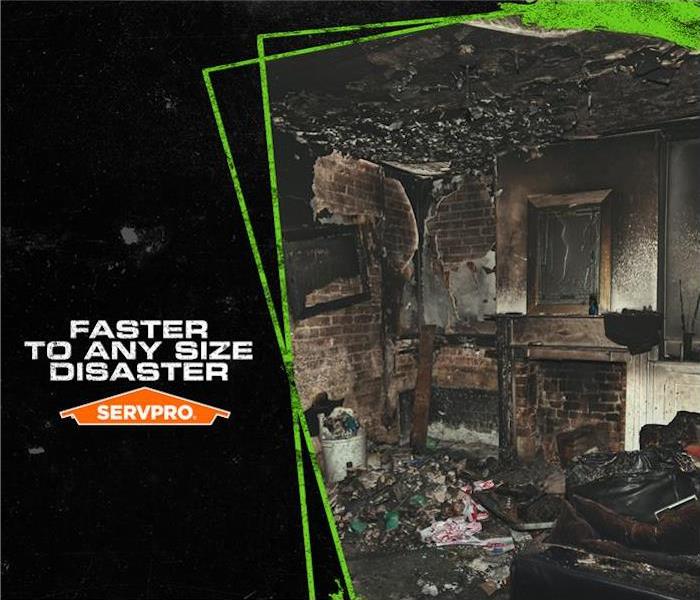 Call the FRST fire and smoke damage restoration technicians from SERVPRO for Salem house fire cleaning and restoration.
Call the FRST fire and smoke damage restoration technicians from SERVPRO for Salem house fire cleaning and restoration.
SERVPRO Provides an Expert Fire Damage Restoration Service
When properties catch fire, one of the leading causes of damage is smoke-related. Combusting materials release toxins into the environment in the form of smoke. Hot smoke travels quickly from the source through the home, leaving behind thick, odorous residues on surfaces. Using a professional restoration service can help make these damages "Like it never even happened."
Homeowners with fire damage in Salem can reach out to SERVPRO to help rescue their structure and contents. You can carry out several tasks to reduce the impact of smoke on your home and belongings. Light vacuuming is a simple but effective way to remove light and dry soot from surfaces. The goal of eliminating these dry, unattached particles with a vacuum cleaner is to prevent them from gradually dropping onto floors and surfaces below. In areas with high foot traffic, loose soot can be driven into carpet fibers or floors, making restoration much more challenging and work-intensive.
Another simple mitigative procedure is to open windows which helps to disperse unpleasant odors naturally. Tackling smoke residues with household cleaning products is not recommended as there may be an adverse reaction that ultimately causes more harm than good.
Meeting the Cleanup Challenge
Our technicians are adept at dealing with the challenges of cleaning complex soot and smoke residues. Cleaning porous surfaces with smoke damage are perhaps the most challenging aspect of restoration. Material porosity absorbs smoke particles and cleaning agents. Unfinished woods, common in cabinet interiors, plasterboard, carpets, and acoustical tiles or masonry are all porous materials in the home. Generally, these materials require a dry-cleaning solution as the absorption of cleaning agents can lead to discoloration or, in some cases, deterioration of the material. One dry cleaning solvent we use is denatured alcohol which can be applied directly to unfinished wood surfaces and allows us to clean with a dry sponge without causing damage. Other materials such as plasterboard can be salvaged if the soot is not embedded into the gypsum.
Fire Damaged Porous Materials and How to Clean Them
- Acoustical tiles that can soundproof walls are best cleaned using light peroxide to remove smoke residues. If embedded with soot, disposal is the required method of remediation.
- Carpeted walls can absorb large amounts of moisture, especially if treated with a fire retardant. We identify the types of fiber and adhesive to determine the best cleaning action.
- Concrete and masonry have a sliding scale of cleaning actions that increase aggressive and agitative methods.
If the ignition source is furnace-related (puff-back), it is common to find that the masonry surrounding the surface is damaged. Mortar, bricks, marble, and cinder block are common types of masonry found in the home. If dry cleaning with sponges is not possible, we may resort to an alkaline cleaning agent alongside water to remove soot, then rinse the surface with pressure washers or hoses. Since water and alkaline cleaners can discolor masonry, it is vital to pre-test these methods on an inconspicuous part of the material before applying them to the entire surface. Using solvents on surfaces also requires dwell time and correct mixing of solvents to ensure the best results.
Aggressive Cleaning Methods for Masonry
- For stone and brickwork, high acidic solvents can help remove smoke damage.
- Avoid using acids on polished marble or porcelain as they may corrode finishes.
- Abrasion blasting is the most aggressive action that changes the material's surface. Dry ice pellets offer the most practical non-moisture abrasion method. This can be damaging in itself if the material has historical value.
Property fire damages can become permanent without professional intervention. Contact SERVPRO of Salem / Peabody / Marblehead for fire damage restoration at (978) 744-4545.
Fire Restoration Experts Rebuild Burnt Homes in Peabody
8/15/2022 (Permalink)
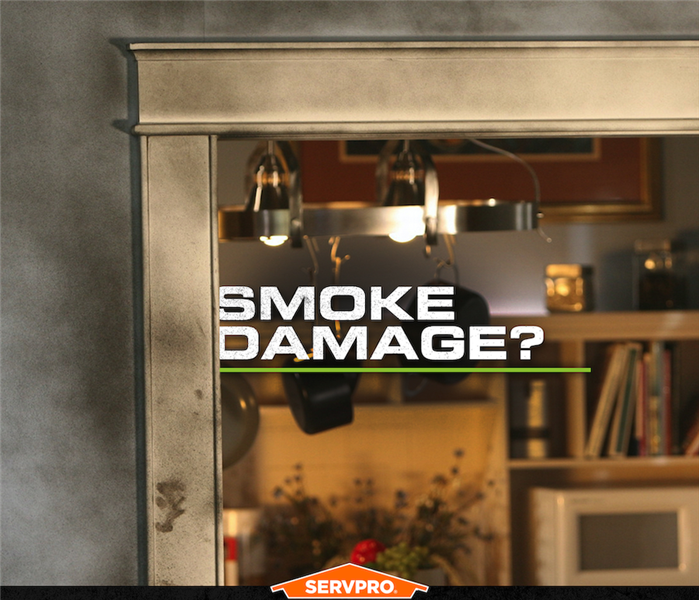 Fire and smoke damage remediation is no easy task. Call SERVPRO for the help you need.
Fire and smoke damage remediation is no easy task. Call SERVPRO for the help you need.
Cleaned Up and Made Livable with Fire Restoration
Firefighters use water or foam to extinguish the fire when a home catches fire. Water makes it so things can no longer burn, and foam works similarly by blocking oxygen from getting near anything that can fuel the fire. Either can save your house in Peabody, but thousands of gallons of water can leave such residential properties with additional restoration needs.
The technicians at SERVPRO can handle any fire restoration work our Peabody customers might need. We want to make your damaged home a place that you feel comfortable and safe living in again.
Because fire restoration work requires more than mere cleaning away of soot and removing odors, SERVPRO specializes in rebuilding and reconstructing homes and businesses. This specialized work includes :
- Roofing repairs and reconstruction of attics, including insulation installation,
- Reconstruction of window frames, and
- Cleaning up of water or foam used by the fire department.
Firefighters often open up the roof when a house burns to gain control over the fire. Such holes allow pests like raccoons and birds, rain, and debris from overhead trees to enter your residence. We get these openings tarped immediately upon arrival and rebuild the damaged structures, including shingles and gutters. We often remove any existing insulation and install new batting or blown-in insulation.
Window frames often swell and warp during a fire. Glass can become cracked, also. These changes can make it difficult or even impossible to open and close windows. We can remove these when we perform any other needed controlled demolition work and then reinstall new windows and frames.
The fire department’s goal is to put it out as quickly as possible whenever a fire breaks out. Often using water, they create another mess while gaining control over the initial catastrophe. Restoration includes water extraction, drying the floors and walls, and the air with a combination of air scrubbers and desiccation machines.
Call SERVPRO of Salem / Peabody / Marblehead at (978) 586-2915 for professional services from trained and competent restoration experts.
Need Fire Damage Restoration in Peabody – Call SERVPRO
7/18/2022 (Permalink)
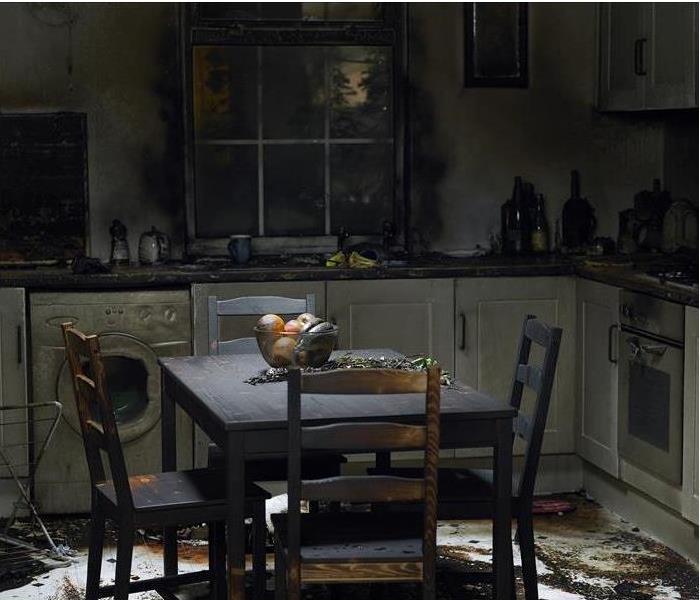 For fast and efficient service call SERVPRO of Salem / Peabody / Marblehead at (978) 744-4545.
For fast and efficient service call SERVPRO of Salem / Peabody / Marblehead at (978) 744-4545.
SERVPRO Provides Water Cleanup and Fire Damage Restoration in Peabody
Fires cause a devastating amount of damage in Peabody homes every year. Many fires begin in the kitchen; however, they can also start in bathrooms, garages, and family rooms. Poor electrical connections, smoking, overheated appliances, and inattention to food cooking on the stovetop are some of the common causes of fires in homes.
SERVPRO provides fire damage restoration services to residents of Peabody and the surrounding area. Regardless of where the fire started, there is often damage to other portions of the living space from smoke residues and odors, as well as fire retardants used by the fire department to quell the fire. Water can seep into rooms below the fire, causing ceiling tiles to sag or collapse and floor materials to absorb moisture.
Our team assesses the situation and the amount of damage to identify the solutions needed to address every area of your home damaged by the fire. Controlled demolition techniques remove damaged items and structures that cannot be cleaned and restored. Weighted extractors and floor drying mats extract water from carpets and hardwood flooring. We clean every surface, removing all smoke residue from both porous and non-porous materials. We use air movers and dehumidifiers to return humidity levels to normal.
Our building services team assists with the restoration and repair of structural items, including electrical, plumbing, flooring, walls, and cabinets, to return your home to its original condition, “Like it never even happened.”
Our SERVPRO team provides the following services to help our clients after a fire causes devastating damage:
- Water & fire damage restoration
- Smoke remediation
- Fire damage repair and house fire cleanup
Call SERVPRO of Salem / Peabody / Marblehead for fire damage restoration services. We cover Peabody and nearby areas. We can help 24/7. Call (978) 744-4545.
Fire Restoration and Cleanup in Peabody
3/14/2022 (Permalink)
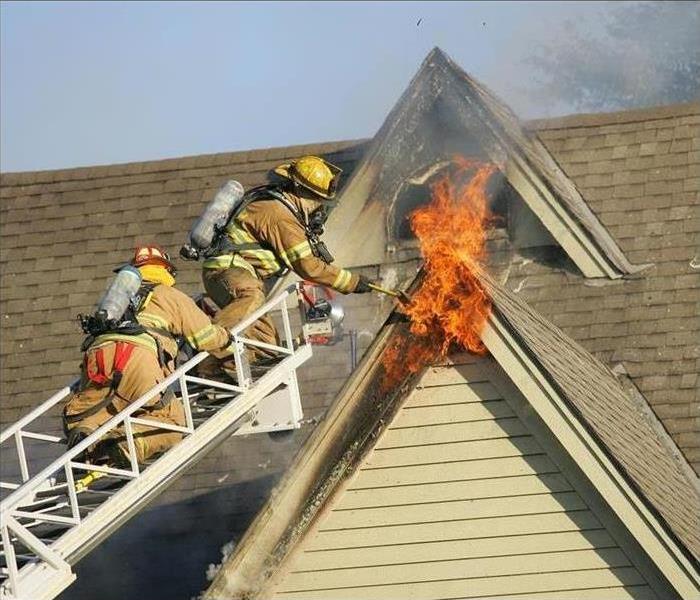 Explore your options with SERVPRO of Salem / Peabody / Marblehead.
Explore your options with SERVPRO of Salem / Peabody / Marblehead.
SERVPRO Provides Fire Restoration, Cleanup, and Repairs in Peabody
Even a small fire in your Peabody home can cause extensive damage. The fire causes damage. Water and chemicals are used to quell the blaze that also causes damage. In addition, smoke residues and odors may extend throughout the entire home or commercial building. Many clients assume everything must be replaced!
SERVPRO provides fire restoration services to our clients in Peabody and the surrounding areas. Our team is available to respond 24/7. We believe a great deal of secondary damage can be mitigated if our team members begin the cleanup as soon as the fire department leaves the site. Removal of fire-damaged materials reduces the odor. Fast removal of water and chemicals minimizes the opportunity for porous materials to absorb moisture, swell and become permanently damaged.
One of our team managers assesses the situation and identifies those items that can be cleaned and restored vs. those that must be removed and replaced. Our emphasis is on removing the soot and cleaning. Our smoke residue experts review the following characteristics to help in deciding what can be cleaned and restored vs. replaced:
- Locate the residues relative to the location of the fire.
- Determine the type of residues – oily, light, fluffy, etc.
- Surface type – porous and non-porous, fabrics, etc.
- Cleaning process – We use different cleaning processes based on residue, surface, and concentration. These processes include:
- Temperature application,
- Agitation,
- Chemical action and
- Dwell time
We use all of these different cleaning approaches in many fire situations. We base the decision on the type of fire, the material burned, the distribution of smoke residues and odors to the rest of the dwelling. Let the experts at SERVPRO restore your home, “Like it never even happened.”
Call SERVPRO of Salem / Peabody / Marblehead and nearby areas for assistance with fire restoration. We can help 24/7. Call (978) 744-4545.
Clearing Dry Smoke Soot from Walls and Ceilings in Peabody Homes
2/24/2022 (Permalink)
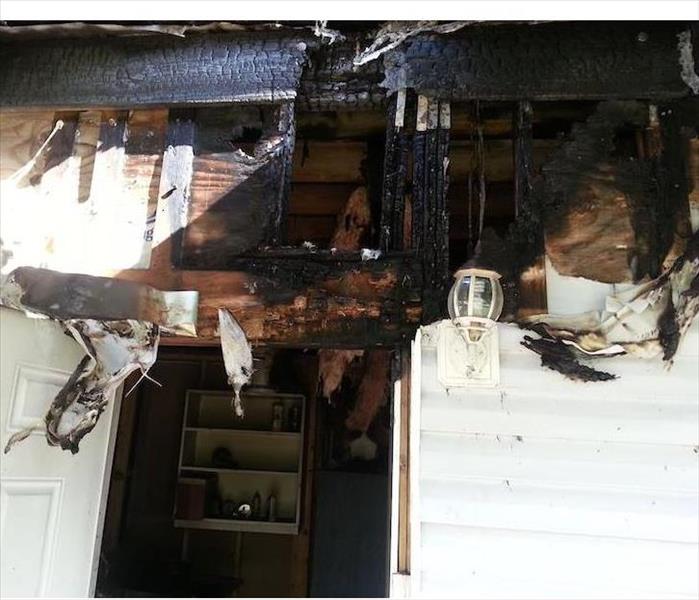 Looking for a restoration company? Look no further, SERVPRO of Salem / Peabody / Marblehead is just a call away at (978) 744-4545.
Looking for a restoration company? Look no further, SERVPRO of Salem / Peabody / Marblehead is just a call away at (978) 744-4545.
There are Specific Dry Smoke and Fire Damage Restoration Practices in Peabody Homes
There are many levels of emergency services and mitigating actions possible after a structure fire. As threatening as these events can be, it is important to get work started as soon as possible on the initial mitigation solutions like:
- Temporary board up
- Debris removal
- Air quality improvement
How Does Dry Smoke Affect Surfaces?
The need for fire damage restoration to Peabody homes describes several actions to get underway quickly. Soot removal and management are among the more formidable fire damage obstacles to overcome, and this can worsen the more that dry smoke particles can spread through the property. High-porosity materials can have smoke solids infiltrate the surfaces, while other horizontal and even vertical surfaces can become coated with a thin layer of smoke solids and debris.
How Can These Materials Get Cleaned?
A chemical sponge is one of the most common approaches to overcoming dry smoke residues and soil deposits. This rubber material of the sponge pulls soils away from the affected surfaces, most often without allowing any impact to the underlying substrate. Our team can also use dry vacuums to remove loose debris and particles from the surface to make these wipe cleaning approaches more efficient and thorough.
What Other Post-Fire Cleanup is Needed?
Oily residues and wet smoke damage can be more formidable obstacles in the cleanup process. While dry smoke is thinner and more easily managed, varying types of damage exist based on the combusted materials involved. We must prepare for a wide array of possible cleanup needs to dissolve with solvents or emulsify solids with detergents.
Cleaning up after smoke damage is critical for homes after fire damage exposures. Using a combination of wet and dry-cleaning practices, we can remove dry smoke residues and other threats preventing a return to preloss condition. Give our SERVPRO of Salem / Peabody / Marblehead team a call at (978) 744-4545.
Protecting Your Peabody Property During Fire Damage Restoration
2/2/2022 (Permalink)
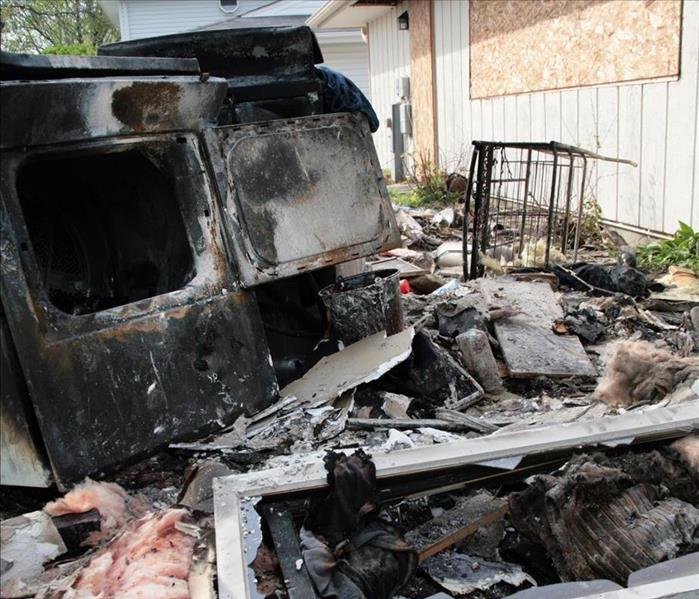 SERVPRO can board up fired damaged houses in Peabody to mitigate the damage as we begin the interior cleanup and restoration
SERVPRO can board up fired damaged houses in Peabody to mitigate the damage as we begin the interior cleanup and restoration
SERVPRO Has All Areas Covered During Peabody Area Fire Damage Restoration
Peabody sees all four seasons, which may mean extreme heat in summer and wild storms during the winter months. Whenever your property gets ravaged by fire, you need a crew on-site and ready to protect your structure so that restoration efforts can move forward. SERVPRO is constantly perfecting the process of mitigation and restoration for all fire and water emergencies. When you call on us, you can also guarantee We’re Faster to Any Size Disaster.
When your home requires fire damage restoration in Peabody, all interior contents must remain protected as SERVPRO works. Part of our restoration service includes board-up and tarping to help protect your home until we can bring it back to pre-fire condition. We respond fast and get everything necessary to keep unwanted guests, pests, and harsh weather elements out.
Interior Protection Service
- Boarding up and tarping is not exclusive to our storm response calls – We use them for any fire and water remediation calls to protect residences and businesses alike.
- Tarping involves plastic sheeting or tarps to cover up any holes in your structure, especially helpful for roofing damage.
- Board up involves plywood for covering doors, walls, and windows damaged by fires, storms, water damage, and more.
Once a fire disaster strikes, it may take a while for your home insurance adjuster to inspect and assess all damages. During that time and before repair may begin, your property needs protection. SERVPRO ensures everything is covered so that your contents are safe during the transition mode. We then get going on the initial phases of assessment with our crew chief to put the fire remediation and restoration plan in place.
SERVPRO of Salem/Peabody/Marblehead understands that a fire causes immense stress and devastation for all homeowners. We are the skilled fire damage restoration team you need so that everything is left “Like it never even happened." Reach us for 24/7 emergency service by dialing (978) 744-4545 or requesting help online.
Debris Removal During Fire Restoration in Your Salem Property
1/22/2022 (Permalink)
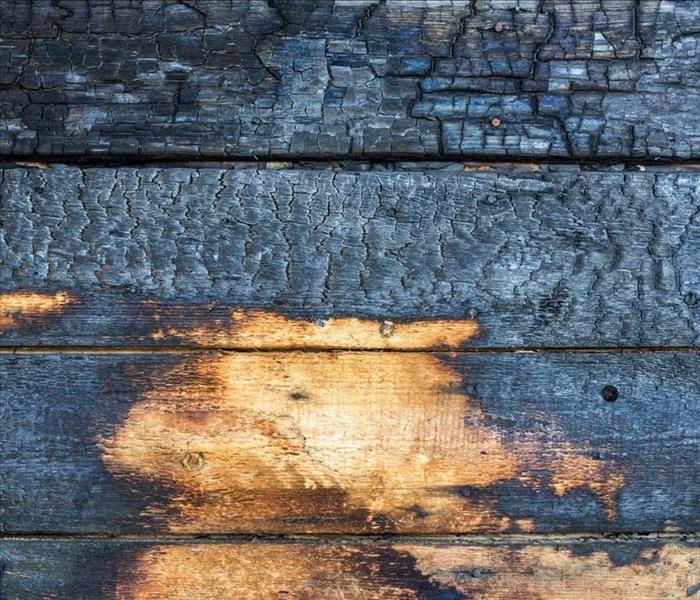 SERVPRO can removed charring to salvage building elements after a Salem house fire, "Like it never even happened."
SERVPRO can removed charring to salvage building elements after a Salem house fire, "Like it never even happened."
SERVPRO’s Fire Restoration Team Handles All Charred Debris for Salem Residents
There is never such a thing as a one-size-fits-all approach to handling housefire cleanup. When you call SERVPRO to your Salem home, we take the time to thoroughly assess every aspect of your property to ensure we follow the best route to get you results. Not only does this involve soot and smoke remediation, but we also dive deeper to remove all charred debris. Part of this includes ensuring that structural integrity remains intact for safety reasons.
With our fire restoration in efforts in Salem, we will leave your property “Like it never even happened.” To do so, SERVPRO follows proven protocols that include debris removal, drying of all areas saturated with chemicals or water, pack-outs for removing and storing or cleaning items, and controlled demolition.
Did You Know?
- The interior of charred wood usually retains structural integrity.
- Larger wood members within your structure may not require replacement after a fire event.
- With any wood members that present with charring on the outside, we can use methods to remove it, such as sanding, soda blasting, or ice blasting.
We Handle All Fire Debris Safely
Our fire and smoke restoration technicians (FSRT) understand the impact of combustion on the occupants of your home. Any burned, charred remnants of contents, fuels/chemicals, and organic matter can overwhelm the property leaving pungent odors and toxic soot. Our professionals understand best practices for removing charred debris to lessen these effects, allow us more working space to handle the project, and meet our restoration goals.
Our team at SERVPRO of Salem/Peabody/Marblehead strives to ensure you can get the results you deserve when you call on us for fire restoration. We leave no stone unturned so that you can get your routine back on track, enjoying your home once again. Give in touch with us when you need assistance at (978) 744-4545, and we can mobilize a crew to your door any time – day or night.
How to Set Up a Fire Safety and Prevention Plan in Salem for Families
10/27/2021 (Permalink)
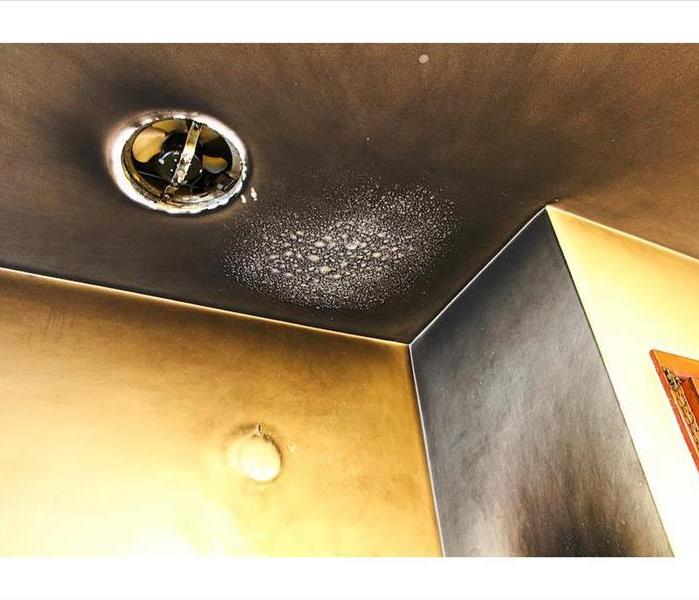 SERVPRO handles all kitchen fires with fast and immediate service we are here to help.
SERVPRO handles all kitchen fires with fast and immediate service we are here to help.
SERVPRO Team Members Have Comprehensive Training for the Safe Handling of Fire Damage in Salem Properties
Preventing a situation in a Salem home that results in the need for house fire cleanup is smart. There are numerous ways homeowners can inspect their own properties regularly and look for potential fire hazards.
SERVPRO offers the following tips for fire safety and prevention in Salem homes. The basics for all the various types of fires that can occur are rooted in commonsense and diligence. Some of the typical reasons for fires are:
- Overloaded electrical sockets
- Flammable chemicals or paints stored near a flame such as a gas water heater
- Leaving candles unattended
- Incorrect use of appliances such as putting items with rubber on them in a dryer on a high heat setting
The holidays also bring the danger of fire. Christmas trees that become dry can ignite from the heat generated by the strings of lights. A daily check of the needles on the branches in a few places can catch a potential hazard before it becomes a real one.
The kitchen is an area in the home where a large number of fires occur. Putting a frozen chicken breast in hot oil can result in many flames that spread rapidly throughout the room as the ice melts upon contact and turns to vapor, expanding the fire with it as it rises. Salt or baking soda are good ways to extinguish this type of fire if a tight-fitting metal lid is not within reach. Water, sugar, or flour can fuel the fire even more and should not be relied upon for putting out a flaming grease fire.
SERVPRO of Salem / Peabody / Marblehead at (978) 744-4545 brings years of professional fire safety and prevention knowledge to local Salem homes. SERVPRO is available for inspections to locate potential hazards or, if fire damage occurs, a complete house fire cleanup and restoration of the property.
Can Professional Fire Damage Restoration in Salem Return Hardwood to Previous Function and Appearance?
9/30/2021 (Permalink)
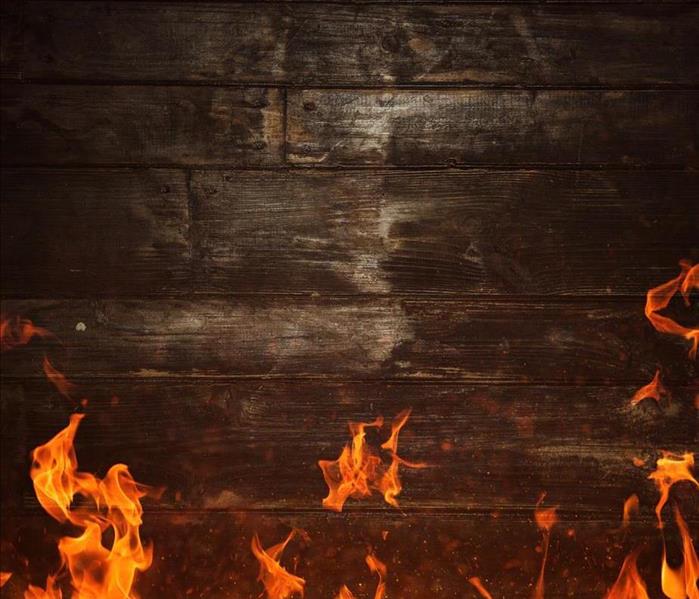 Fire damage to your hardwood floor can be salvaged if caught early enough. Let SERVPRO use their fire damage restoration technology.
Fire damage to your hardwood floor can be salvaged if caught early enough. Let SERVPRO use their fire damage restoration technology.
SERVPRO Salem house fire clean up includes restoring hardwood furnishings and fixtures after smoke damage
The aftermath of the heat and smoke of a household blaze looks grim, and it can be hard to believe that Salem fire damage restoration is even possible. Tear out and repairs or replacement are prohibitively expensive, plus your home risks loss of its unique ambiance, heirlooms, and other treasures.
Can SERVPRO Restore Hardwood Contents Successfully?
Floors, trim, furniture, built-in cabinets, and more are commonly made of hardwood and suffer from varying degrees of smoke and soot damage after a fire in Salem. Our SERVPRO team of Institute of Inspection, Cleaning and Restoration Certification (IICRC)-trained technicians have a wide variety of strategies at their disposal to remove the soiling and odor, permitting successful restoration.
What Are the Challenges of Cleaning Fire and Smoke Damaged Hardwood Contents?
When evaluating hardwood after a fire, the type of finish and the extent of the damage determines restoration success. Here are the things SERVPRO takes into consideration:
With no protective barrier, porous unfinished wood absorbs smoke odors and residues. Dry cleaning methods are the most effective, including vacuuming, dusting, brushing, and sponging. Using a water-based cleaner risk forcing soot and odors deeper into the cellular structure of the wood. Denatured alcohol is an option if other methods fail.
Many substances protect hardwood, including varnish, shellac, lacquer, paint, oils, or waxes. The type of finish impacts the hardwood’s response to heat, soot, moisture, and odors. SERVPRO chooses cleaning products (oil or water-based) and adapts cleaning approaches based on the finish.
When moderate damage is evident, SERVPRO selects from among the following interventions:
- Low alkali surface cleaners, spray and wipe, for moderate residues
- Wood oil soap, cleaning in the direction of the grain
What Are Options for Badly Damaged Hardwood?
If the hardwood surface is compromised with significant blistering or staining, uncomplicated restoration might be impossible. “Semi-refinishing” of the hardwood can resolve issues, accomplished with solvent-based cleaners that remove a thin layer of the damaged finish. Mild abrasives help but require application by a trained professional to avoid further damage.
Contact SERVPRO of Salem / Peabody / Marblehead for an honest evaluation of hardwood fire damage. Call (978) 586-2884 to schedule an assessment.
When a House Fire Strikes Your Salem Home
5/26/2021 (Permalink)
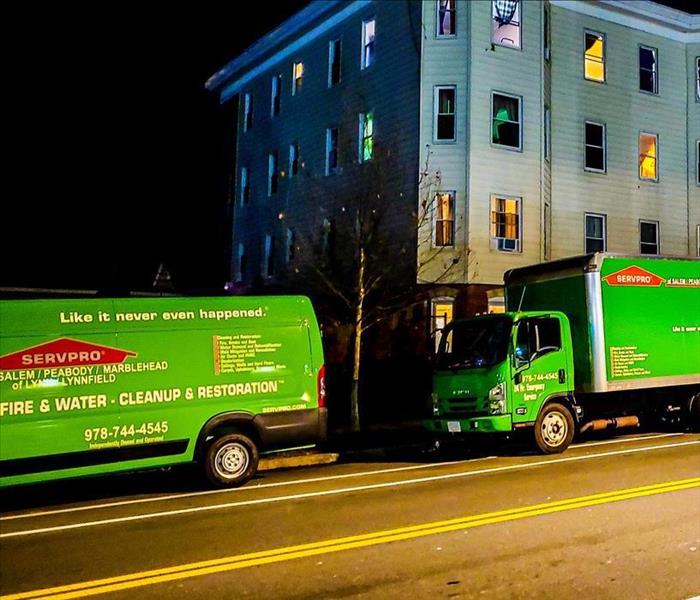 Fire and Smoke Cleanup for Salem Buildings is a phone call away for SERVPRO--24/7/365
Fire and Smoke Cleanup for Salem Buildings is a phone call away for SERVPRO--24/7/365
Rely on SERVPRO to Restore Your Fire Damaged Contents in Salem
Fire damage incidents in Salem are unpredictable, and when they happen, most property owners do not have the experience to determine what is salvageable and what needs to be replaced. Our SERVPRO technicians have the experience and skills to help you restore the salvageable items and advise on what to replace or refinish. By working with our team, you save on fixing what you could have easily discarded
Which Fire and Smoke Cleanup Methods Do SERVPRO Technicians use in Salem?
The method that our SERVPRO technicians choose to clean items in your fire-damaged home in Salem depends on several factors. For instance, the restoration procedure we use to clean grease-based smoke particles from the walls is different from the one we can use to clean non-grease soilings off the floors. We can use clean sponges to dry-wipe light to medium residues from hard surfaces such as tiled floors. Additionally, we can do the following
- We can wet-clean surfaces such as walls that have heavy to moderate residues
- We can spray and wipe to clean electronics that are likely to be damaged if thoroughly saturated (outside covers only)
- Through abrasive cleaning, we can clean soot particles off metallic surfaces
- Perform deodorization to neutralize odors
SERVPRO of Salem / Peabody / Marblehead can professionally clean your property to make it feel like home again. Call 978) 634-3371 to work with a locally-owned firm.
Why is Fire and Smoke Cleanup Challenging for Salem Residents?
5/3/2021 (Permalink)
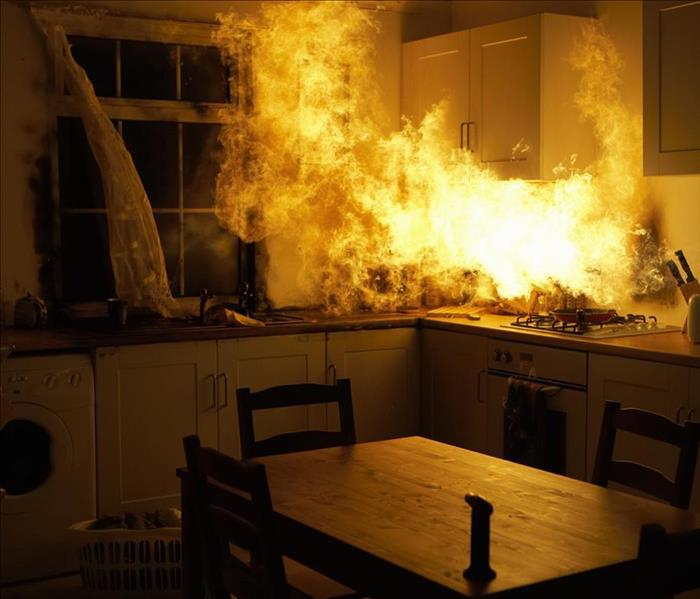 Smoke and soot damage is no easy task. SERVPRO has IICRC certified-trained technicians with the experience you are looking for.
Smoke and soot damage is no easy task. SERVPRO has IICRC certified-trained technicians with the experience you are looking for.
SERVPRO is Trained to Recognize and Remove Different Types of Fire Damage from your Salem Home.
Smoke can permeate a structure quickly during a fire. These aerosols made up of carbon, chemicals, and liquid can also adhere to surfaces in your home, making them a challenge to remove. While opening windows and light-vacuuming can help to reduce losses, we recommend that you contact a professional service for help with:
- Fire damage restoration
- Fire and smoke damage
- Fire damaged homes
Our fire and smoke cleanup team in Salem can mobilize equipment and workforce in as little as four hours after receiving notification of loss. Local technicians can provide insight into the unique material construction and building assembly of your home. These benefits allow us to be confident of returning your property to its preloss condition after the fire.
- We use cutting-edge technology and the theory of fire to enact a modern solution to removing soots and smokes.
- Equipment such as abrasion cleaners, compressed air, and jet washing can remove smoke residues quickly.
- Our comprehensive odor control strategies can reduce the secondary damages associated with fire.
Get your home back to a normal condition. Contact SERVPRO of Salem / Peabody / Marblehead for fire and smoke cleanup at (978) 744-4545.
What Mitigation Begins Fire Damage Restoration in Peabody Homes?
4/29/2021 (Permalink)
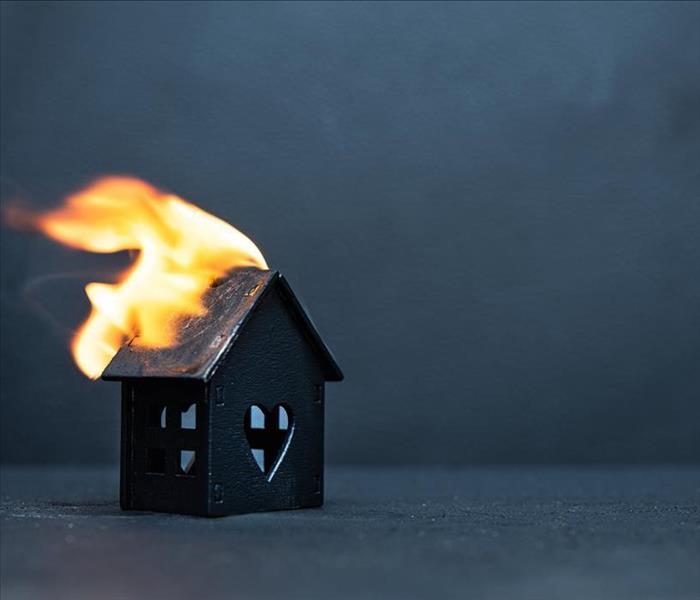 Fire restoration for your home is a must when the time comes. SERVPRO has the manpower and equipment for any size disaster.
Fire restoration for your home is a must when the time comes. SERVPRO has the manpower and equipment for any size disaster.
Air filtration can make post-fire environments in Peabody properties safer.
Fire damage restoration often hinges on the initial actions that our SERVPRO professionals can take after extinguishment. House fire clean up can often be lessened with prompt emergency services and fire restoration mitigation starting right away. Among the most critical of these services is removing harsh particles circulating in the environment.
What Tools and Devices Remove Smoke Damage from Peabody Homes?
Carcinogenic particles are a potential obstacle for fire restoration in Peabody properties, which initial filtration can help to resolve. Improving indoor air quality (IAQ) allows the workspace to be safer for responding technicians and occupants of the house. We can often capture many of the hazardous soot and smoke particles with HEPA filtration products in our inventory, including:
- Air scrubbers
- Hydroxyl generators
- HEPA vacuums
- Negative air pressure ventilation to exterior
As challenging as post-fire effects can be, having prompt and knowledgeable fire damage restoration can help. Our SERVPRO of Salem / Peabody / Marblehead team is ready 24/7 at (978) 744-4545.
Do you Have Soot Residues After a Fire in Salem?
4/1/2021 (Permalink)
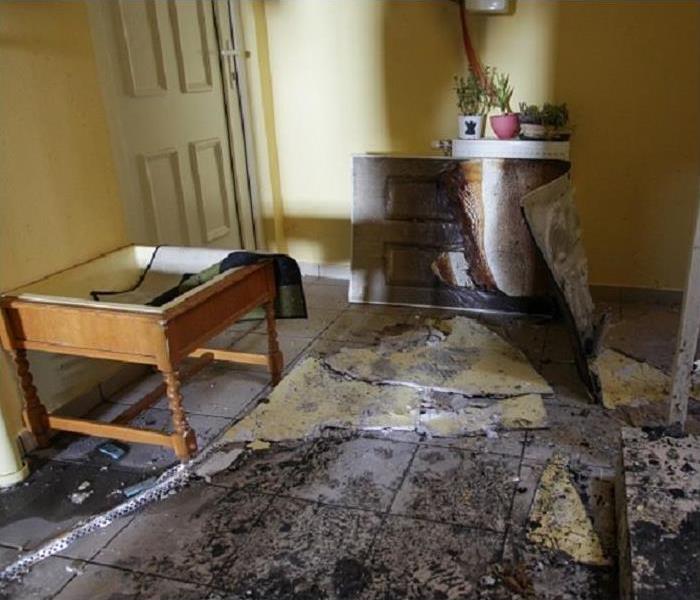 SERVPRO has the cleaners and know-how to effectively clean your fire damaged possessions.
SERVPRO has the cleaners and know-how to effectively clean your fire damaged possessions.
SERVPRO can Provide Cleaning and Restoration Services in Salem
Once a fire ignites, it begins releasing partially combusted particles into the atmosphere. These particles can then travel throughout your structure and leave behind residues when contacting cooler surfaces.
When conducting fire restoration in Salem, our SERVPRO technicians put many efforts towards cleaning soot residues from your contents and building materials. Contents include your possessions and anything that is not permanently attached to your building. We can clean residues off of your contents using the following methods:
- Foam Cleaning: We can use foam as a cleaning agent when working with upholstery fabrics. This method works well when cleaning light residues on delicate materials.
- Abrasive Cleaning: In some situations, we can use a cleaning method to agitate the surface during cleaning. Abrasive methods work well when dealing with heavy residues on hard, non-porous surfaces.
- Immersion Cleaning: This technique works well for cleaning items that can be completely saturated with a chemical solution. Smaller items and other contents like Venetian blinds clean up well when soaked in Ultra Content Cleaner and hot water.
If your contents ever get coated by soot after a fire, call SERVPRO of Salem / Peabody / Marblehead at (978) 744-4545.
Explore A Historic Salem House From The Comfort Of Your Own Home
1/4/2021 (Permalink)
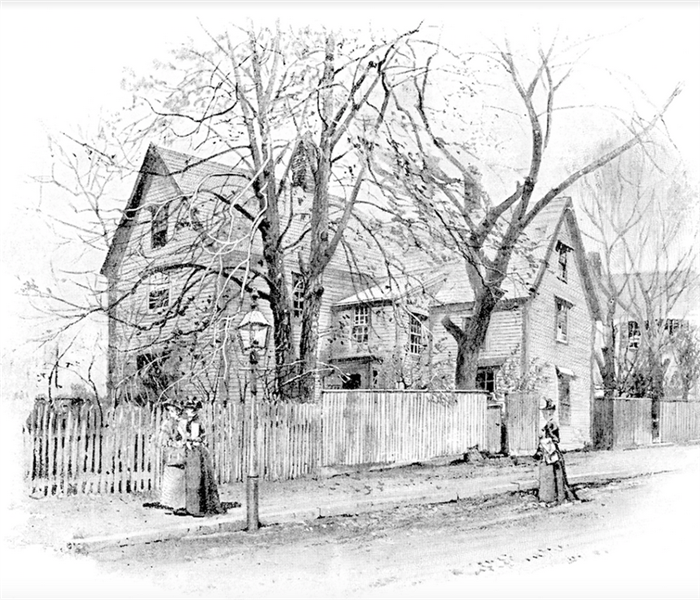 It will be exciting to see the community enjoying the virtual tours to The House Of The Seven Gables.
It will be exciting to see the community enjoying the virtual tours to The House Of The Seven Gables.
Salem’s House Of The Seven Gables Is Open For Virtual Tours
People come from far and wide to visit The House Of The Seven Gables in Salem. The house rose to fame after Nathaniel Hawthorne’s 1851 novel of the same name, which was based on the very same house. This winter, you can take a virtual tour of the house from the comfort of your own home.
- Enjoy a pre-recorded guided tour of the mansion.
- A brand new 3D tour was added for this season.
- Explore one of North America’s oldest homes.
Tour tickets cost $10 or are free to Gables members. There are slots available throughout December and early January. Visit the Seven Gables website for more details and to book your tickets. Ticket sales support Seven Gables’ work to be a welcoming site for visitors.
Whether you live in a historic home or a modern duplex, it is essential to be aware of fire risks. If you need help with fire damage restoration, call SERVPRO of Salem / Peabody / Marblehead at (978) 744-4545.
History and Culture Awaits You In Salem
12/17/2020 (Permalink)
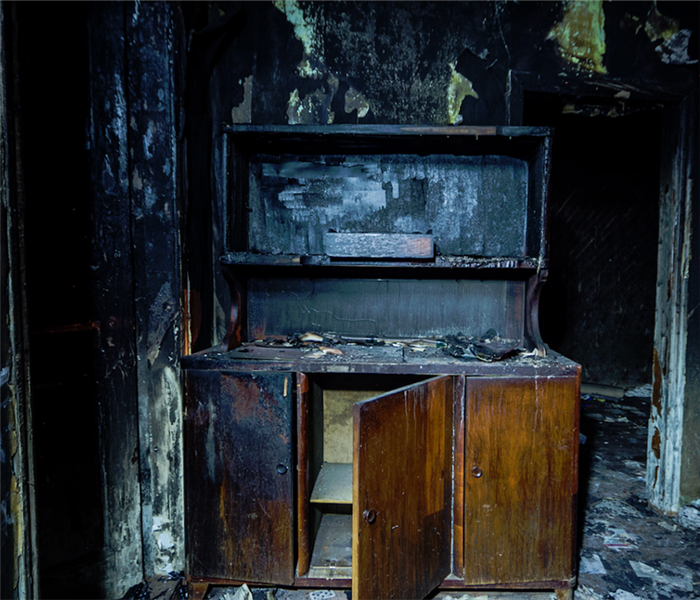 Don’t let fire damage keep you out of your home for long. Contact SERVPRO immediately for effective remediation services.
Don’t let fire damage keep you out of your home for long. Contact SERVPRO immediately for effective remediation services.
The Famous Witchy Town Offers Enchantment To Visitors
Salem is synonymous with witchcraft and magic. It is impossible to hear the name without thinking of the witch trials, and even today, Salem is a popular setting for spooky movies and shows. Scenes from Sabrina the Teenage Witch, Hocus Pocus, and Bewitched were filmed here, along with Bride Wars, Lords of Salem, and American Hustle. The town also has a namesake in Sabrina the Teenage Witch, who named her cat Salem.
In 1626, a settler named Roger Conant arrived from Cape Ann and chose to settle and start a town. The town's name, Salem, is a reference to Shalem, a word which is officially identified with Jerusalem. The town was given this name in honor of the peaceful transfer of power when John Endecott took over from Conant as the town leader.
Salem is well known for its witch trials, but it is famous for other reasons too:
- Salem seafarers were bold and adventurous, and Salem established successful trade routes to Asia and India.
- Salem is officially designated as the birthplace of The National Guard. Every year, members of the Second Corps of Cadets gather to lay a wreath, sound bugles and fire a 21-gun salute.
- Elias Hasket Derby hailed from Salem – he is widely considered to be American's first millionaire.
- In 2011, Salem set the record for the highest price ever paid for a piece of Federal furniture, when a private collector paid a staggering $662,500 for a carved mahogany side chair.
Witch Related Tourism Gives A Sombre Look Into The Past
Salem bills itself as The Witch City, which is unsurprising considering the famous Salem Witch Trials of 1692 and 1693. The trials began after several teenagers and younger girls, including Elizabeth Hubbard, Abigail Williams, and Betty Parris, accused several townspeople of witchcraft. By the time the trials ended, more than two hundred people had been charged, and of those two hundred, thirty were found guilty. Twenty people were killed (including Giles Corey, who refused to enter a plea), and at least five others died in jail.
Although Salem embraces its witch-related history, there has also been concern over whether it should keep the close association or focus more on its other cultural aspects. In recent years, a memorial was set up to remember those who died in the trials. For many years, people believed the victims died at Gallows Hill. In 1921, historian Sidney Perley discovered that the correct location was Proctors Ledge. The town purchased the land as "memorial land" but did not build a memorial, partly because the dark period of Salem's past was a source of shame.
However, in 2017, on the hangings' 325th anniversary, the Salem Witchcraft Museum unveiled a memorial. It is a simple stone semi-circle, with the names of the victims carved into it. The memorial lets Salem acknowledge and preserve its history in a respectful way and gives those interested in the witch trials a focal point to visit and remember.
You can also view the Jonathan Corwin House, which is also known as The Witch House. This house is the only building still standing in Salem, which has direct ties to the witch trials. Judge Corwin was one of those asked to investigate the allegations of sinister activity. The house itself is a fine example of seventeenth-century New England architecture. In the 1940s, it was moved slightly from its original location to its current one and carefully restored to historical accuracy.
Explore The Many Historically Significant Buildings In Salem
With such a long history, it is little wonder that Salem has so many historical buildings to explore. Anyone interested in history will want to stop and see:
- Hamilton Hall is an impressive three-story brick building, with the bricks arranged in the Flemish Bond style. Samuel McIntire designed the building in 1805 as a social meeting place for Salem's most prominent families. It was named in honor of the Founding Father Alexander Hamilton. The hall still functions as a meeting place today and is frequently booked for social gatherings.
- The Gedney House is an example of a Colonial home, and the oldest part of it was built in 1665. The house was built for shipwright Eleazor Gedney, a member of the Gedney family, who were among Salem's founders. The house is famous for its historical carpentry and how well the oldest parts of it have survived the passage of time. The house is now a museum, and though it is not open to the public, you can arrange private tours.
- The House Of The Seven Gables was made famous by Nathaniel Hawthorne's novel of the same name. Construction on the house started in 1668. Hawthorne described the house as if it was a character in the book, with a personality all its own. In 1908 the house was purchased and made into a museum. It was reconstructed to fit what Hawthorne wrote about it in his book, rather than what was historically correct. Today it is a popular museum which also offers educational programs for children.
SERVPRO Helps Salem Residents With Fire Damage Cleanup
In 1914, Salem was afflicted by a blaze that became known as the Great Salem Fire. The fire began with a series of explosions, and by the time it was under control, 20,000 people had lost their homes. The fire caused $15 million worth of damage. Some superstitious residents claimed that the spirit of Giles Corey (who died during the witch trials) had appeared before the fire, which was considered a sign of impending disaster.
Even in the modern world, fire is still a real danger. Thankfully, SERVPRO is here to help with fire damage cleanup. We understand that soot and smoke can leave your home unrecognizable. That is why we aim to clean and restore your home until it looks "Like it never even happened."
Our technicians take care of every aspect of fire damage cleanup. That includes:
- Cleaning away soot damage
- Washing linens
- Restoring furniture
- Overseeing structural damage repair.
We also deodorize your home and leave it fresh.
We can also liaise with your insurance company on your behalf and provide professional evidence of the damage.
If your home suffers fire damage, do not despair. SERVPRO of Salem / Peabody / Marblehead can help. Call us today at (978) 744-4545.
Ten Reasons Your Smoke Detector Goes Off Randomly
6/4/2020 (Permalink)
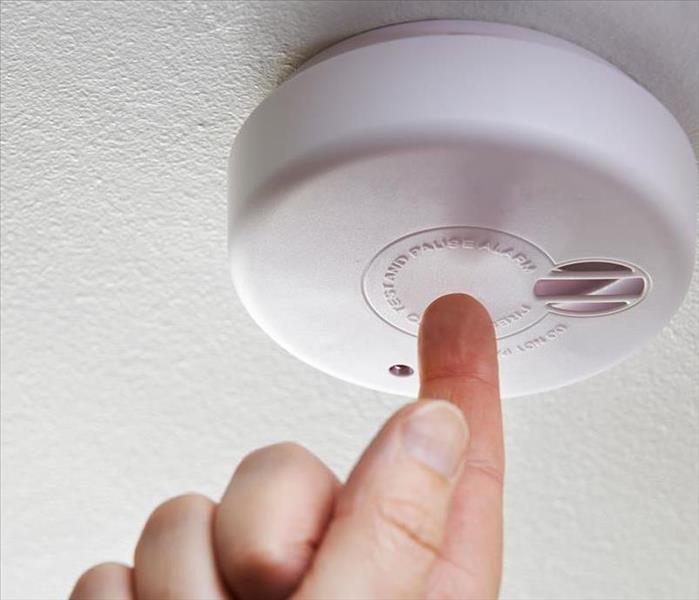 Your smoke detector could be trying to tell you something!
Your smoke detector could be trying to tell you something!
1. Burnt Food on Stovetop
If you don’t supervise the stove when cooking, your dinner may produce smoke, which activates the smoke alarm. In some cases, smoke isn’t even necessary — a hint of burnt food can be enough to set off the detector. Also, make sure your smoke alarm is optimally placed, such as in the hallway leading to the kitchen, not in the kitchen itself.
2. Burnt Toast or Popcorn
Leaving bread in the toaster or popcorn in the microwave for a little too long can happen to the best of us. That sends heavy particles into the air, which your smoke alarm picks up. To avoid this situation in the future, keep your smoke detector at a safe distance from these devices.
3. Fireplaces
Fireplaces can also cause smoke detector false alarms. Your fireplace can sometimes send smoke into your house, which sets off the alarm. This isn’t the alarm’s fault, though. Your chimney may not be clean, and the dampers may not be properly set. Hire a chimney sweep if your fireplace sends smoke into your home.
4. High Humidity
Smoke alarms don’t always distinguish between smoke particles and moisture content. Thus, the density of the moisture particles can trigger your alarm, even if they’re water particles. If you have high humidity in your home, use fans or windows to dissipate the humidity.
5. Steam
Dense water vapor is like humidity when it comes to triggering false alarms. When you take a shower or boil water on the stove, smoke detectors can sense the steam and sound the alarm. Make sure you ventilate your bathroom and kitchen properly to prevent this.
6. Insects
Small bugs love dark crevices in your home, so they may crawl into your smoke detectors, triggering a false alarm. If you don’t know what caused an alarm, open the device and check for small insects. Use pest control sprays around your smoke alarms if insects were the culprit.
7. Chemical Smells
Painting or using harsh chemicals can also cause smoke detector false alarms. Smoke detectors pick up on those chemical odors fast. Ventilate areas where you paint or use chemicals to avoid the startling noise of your smoke alarm.
8. Dust and Dirt
Dust that comes from activities like remodeling may set off your smoke alarms. To clean your smoke alarm, open it up carefully, and look inside for dust or dirt. Use a vacuum attachment or electronic aerosol cleaner to remove dust particles.
9. Low Batteries
When smoke alarm batteries are running low or aren’t properly connected, they typically make small chirping noises. While that’s not the sound of smoke detection, it’s a warning sign that you should check on your device. Replace batteries twice a year — when daylight saving time starts and ends.
10. Old Smoke Alarm
Smoke alarms generally have a lifespan of about 10 years. When they reach the end of their lifespan, smoke alarms may give off false alarms. If your detector is older than 10 years, replace it with a new one right away.
For fire damage restoration, contact SERVPRO of Salem/Peabody/Marblehead
Remember, smoke alarms are meant to be sensitive. If a detector sounds a false alarm, it doesn’t mean it’s broken. Their purpose is to help you catch a fire before it becomes life-threatening. Install your smoke alarms not too close, but not too far away either, from potential fire hazards.
In the unfortunate case where the smoke detector did not give off an alarm, the smoke likely caused heavy soot damage to the property. That fire and smoke damage will need to be handled by professional disaster restoration technicians. This is where SERVPRO of Salem/Peabody/Marblehead comes in.
For fire damage restoration or smoke cleanup, contact SERVPRO of Salem/Peabody/Marblehead today...978.744.4545
Keep Your Backyard Safe From Fire
6/4/2020 (Permalink)
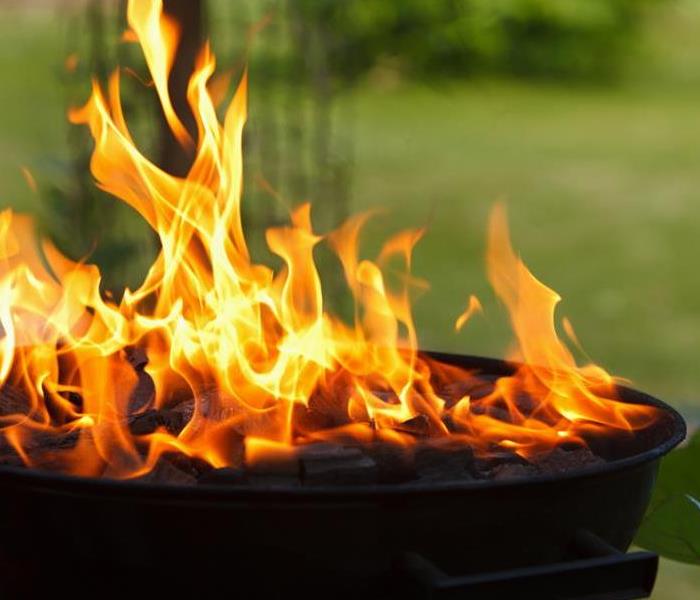 Keep your backyard safe from fires this summer
Keep your backyard safe from fires this summer
As the weather gets warmer, we tend to spend more time in our backyards. Using fire pits and patio heaters, as well as grilling are popular ways to relax in our backyards, but they pose the risk of fire and related injuries. Here are important tips to keep your backyard safe from fire:
Fire Pits
- Keep flammable material and fluids such as charcoal and gasoline away from the fire pit.
- Never use flammable fluids such as gasoline, alcohol, and kerosene to light or relight fires.
- Place your pit at least 10 feet away from any structures, fencing or other flammable material.
- Find a level surface for your fire pit. Don’t place it under tree branches and telephone or electrical wires.
- Don’t allow children to use the fire pit. Keep children and pets at a safe distance away from the fire pit.
- Don’t wear flammable or loose-fitting clothing such as nylon near the fire pit.
- Use only seasoned hardwood to maintain the fire pit. Avoid burning trash, leaves, paper, cardboard or plywood, as well as soft wood such as pine or cedar.
- Don’t overload the fire pit.
- Before you light the fire, check the wind direction and make sure that the lid will still close to extinguish the fire in case of emergency.
- Keep a fire extinguisher, a bucket of water or garden hose nearby to extinguish in an emergency.
Grilling
- Only use propane and charcoal barbeque grills outdoors.
- Place the grill well away from the home and deck railings, and out from under eaves and overhanging branches.
- Keep children and pets at least three feet away from the grill area.
- Remove grease or fat buildup from the grills. Grease and fat burn quickly and can cause burn injuries or fires.
- Always supervise the grill.
- If you have a charcoal grill, use only charcoal starter fluid to light the grill. However, charcoal chimney starters allow you to start the charcoal using paper as a fuel.
- Keep charcoal fluid out of the reach of children and away from heat sources.
- After you finish grilling, let the coals completely cool before disposing in a metal container.
Patio Heaters
- Patio heaters are fueled by liquefied petroleum gas (LPG) that can be dangerous if improperly used.
- Only use patio heaters outdoors in well-ventilated areas. Never use them indoors under any circumstances.
- Don’t use patio heaters when it is windy. Wind can blow out the flame and tip over the patio heater.
- Never allow children to operate patio heaters. Keep children and pets at a safe distance away from patio heaters.
- Ensure the tap is off before changing the gas cylinder and do it in the open air.
- Make sure you know how to turn the patio heater OFF before you turn it ON.
If you’re hosting a party in your backyard, take a look at these tips to prevent fires outdoors.
For professional fire damage repair or smoke remediation services, contact the SERVPRO of Salem/Peabody/Marblehead office at 978.744.4545
The Do's and Don'ts for Cleaning Fire Damage
5/28/2020 (Permalink)
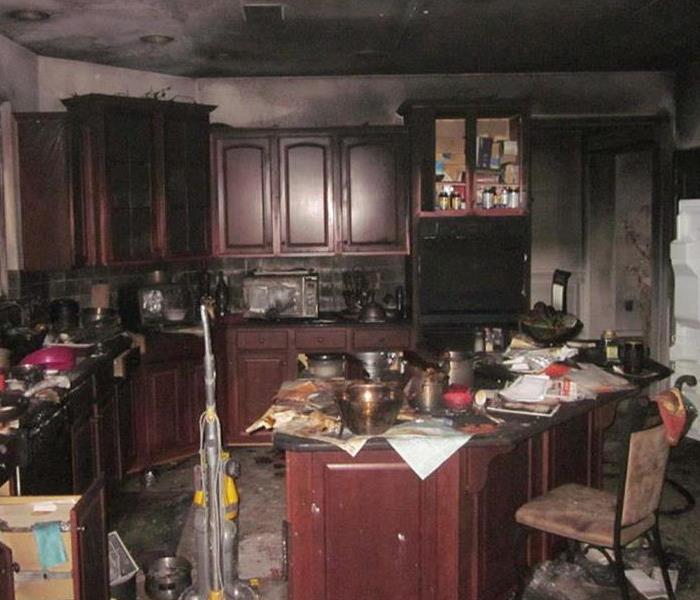 Fire and smoke damage cleanup should be handled by professionals
Fire and smoke damage cleanup should be handled by professionals
DO'S FOR FIRE DAMAGE RESTORATION
Your checklist for after a fire should contain certain non-negotiable tasks, including:
- DO contact the certified restoration specialist at SERVPRO of Salem/Peabody/Marblehead: Make sure you immediately contact a certified fire and smoke restoration professional for remediation services
- DO turn off utilities: Turn of water, electricity, gas, and any other utilities until a professional can evaluate if any of these systems were damaged during the fire.
- DO break out the vacuum: A professional should provide service, but you can enhance the professional’s chances of success by doing the first pass on your own. Use a vacuum with a brush attachment and go over your upholstered furniture. Your furniture will look better as soon as the soot is removed. Also, cover your furniture with a sheet if you need to sit on it while waiting for professional help. This will prevent the soot and ash from grinding into your upholstery.
- DO address your carpets, floors, and countertops: Give similar treatment to your carpets. Vacuum them for an immediate and superficial improvement over the damaged state. It will help prevent soot from grinding deeper into the carpet’s roots. Countertops and hardwood floors should be wiped clean to prevent the soot from deeply staining and clinging to the surfaces.
- DO check your appliances: Your utilities should be off. Make sure empty your freezer and refrigerator, and leave the doors open to prevent mold and mildew. Likewise, winterize your plumbing and drain your hot water heater and boiler. In the absence of heat during the fire damage restoration process, fluids can freeze and cause burst pipes and other damage.
- DO take care of pets: Remove pets from your fire-damaged home. Lingering soot and smoke can be harmful to them.
DON’TS FOR FIRE DAMAGE RESTORATION
Your checklist should also include several things to avoid at all times, including:
- DON’T use your AC, heater or electronics: Wait until a professional arrives on the scene — same with electronics like the television, computers and DVD players. Turning on electronics can create greater damage.
- DON’T clean walls or clothing: Also, do not clean walls, ceilings and other similar surfaces, and wait to clean your clothing and similar garments. A professional should examine them first and provide advice.
- DON’T eat leftover food: Never eat anything that was in the home during the fire. It is most likely not safe to consume due to contamination from smoke, soot, or contaminants introduced to the environment when the fire was being extinguished.
- DON’T wipe away powder from extinguishers: Forgo trying to clean up any staining from the powder discharged by a fire extinguisher. It is best to let professionals guide the clean up of these areas.
These are some basic guidelines for preventing further damage and get a head start on cleanup, but they are not a substitute for professional restoration services. When in doubt, wait for the professionals at SERVPRO of Salem/Peabody/Marblehead. Upholstery, carpets and counters are fine to begin cleaning, but the rest is best left to the pros. And remember, never reenter a home until it has been cleared by the fire department or other local officials.
Only when you have been given a “go” signal by a fire marshal should you consider to start the clean up after fire damage. Always practice proper caution when handling fire restoration work. Wear proper clothing, gloves, and mask. The walls and ceilings are the surfaces that are most commonly damaged by fire and smoke. Insulation should be removed and replaced at any instance of a house fire.
Seeking professional fire restoration services is highly recommended if the extent of the damage is serious enough to address on your own.
ALWAYS CALL AN EXPERT
If you’re wondering what to do after a fire, it’s always tempting to start the cleanup process immediately, and do as much as possible. The best course of action is to call SERVPRO of Salem/Peabody/Marblehead to provide expert knowledge and service. The situation requires specialized tools and knowledge that only a professional can provide. Our trusted professionals will offer an after-fire checklist that will help speed along the fire and smoke damage cleanup process. We will help you restore your property back to like-new condition as quickly as possible.
SERVPRO of Salem/Peabody/Marblehead: 978.744.4545
Cleaning Up After A Grease Fire
5/25/2020 (Permalink)
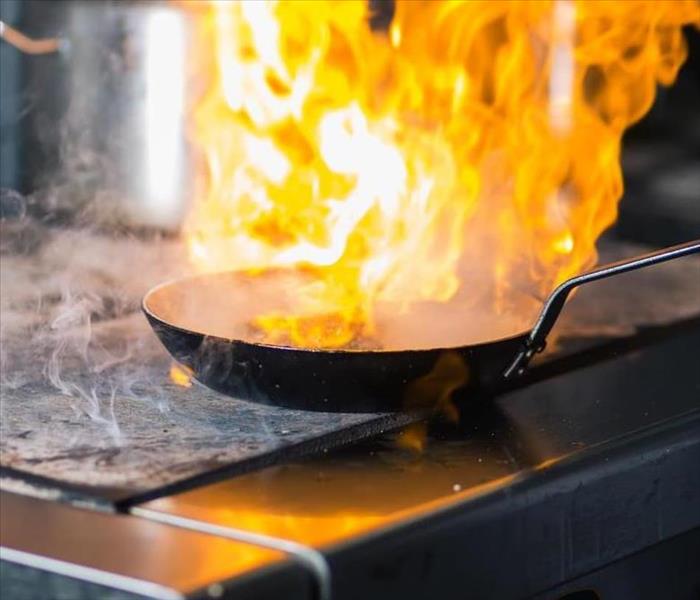 Grease fire cleanup requires help from the professionals at SERVPRO of Salem/Peabody/Marblehead
Grease fire cleanup requires help from the professionals at SERVPRO of Salem/Peabody/Marblehead
A grease fire damage can be an unexpected disaster for your kitchen and home. One of the challenges of grease fires is that they are difficult to extinguish. Pouring water on a grease fire only makes it worse, and trying to snuff it out with towels or other materials close by can lead to the fire spreading. A fire extinguisher is the best way to put out a grease fire so you will want to be sure you have one that is easy to access in your kitchen.
The most common type of fire at home is kitchen fires. Statistics reveal that annually, there are 5,000,000 cooking fires occurring in the U.S. households.
And the reason is that the kitchen is a source of major fire hazards – electricity, heat, gas vapor, and grease.
And of all kitchen fires, fire in ovens is the most prevalent.
Grease fires are very dangerous because they spread out quickly. Before you know it, the fire has already spread all over your kitchen walls, cabinets, and ceilings. Worst, the fire has spread all over your house and made irreparable damage in a split second.
Many cases of grease fire damage usually occur when someone leaves a pan on a stove unattended, or when the oil in a pan overheats and the grease catches fire.
Because it is such a common occurrence, every household owner should be prepared at all times by learning how to put out a stove fire, how to get rid of smoke in the house from oven and clean it up, and most importantly – how to prevent kitchen fire damage.
But then there’s cleaning up after a grease fire damage, which is the second challenge. Just as a grease fire is hard to put out, a grease fire damage is also difficult to clean up.
GREASE FIRE DAMAGE: HOW TO PUT OUT GREASE FIRE
Follow these steps on how to put out a stove fire:
Putting out grease fire requires skills, a speedy reaction, and most importantly – the presence of mind.
- It’s easier said than done, but the best way to confront any emergency situation is to stop panicking and stay calm. Only then will you be able to think of the best solution in the quickest way possible.
- When there are grease fires, one thing you should never do is to pick up the pan. Otherwise, the fire can spread to you or the grease could spill into the counter or kitchen floor, causing the fire to spread easily.
- Do NOT put water to the pan. Doing so could only cause the fire to grow bigger. Before you know it, you have walls on fire.
- Instead, what you should do is cover the pan with a lid to deprive the fire of the oxygen it needs. If you can’t cover it, dump lots of baking soda in it. Once the pan is properly covered with a lid, turn off the burner. Let the pan cool before touching it and cleaning up the mess.
- If the fire is too huge to handle, cease it using a fire extinguisher.
- If you or your clothes catch on fire, stop, drop and roll. This is life-saving technique is applicable for all types of fire emergencies.
HOW TO PROPERLY CLEAN UP AFTER A KITCHEN GREASE FIRE
Now that you successfully put out the grease fire, breathe and give yourself a pat on the shoulder.
Your job has not ended though. The next thing to learn is how to get fire smoke smell out of the house, along with the soot, residue, and debris.
Cleaning up after a fire is a laborious, intensive process. It’s much better to solicit help from family members or friends to save time and energy.
Follow these steps to clean up after a grease fire damage:
OPEN AND WINDOW AND TURN ON A CEILING FAN
Turn off your HVAC system to prevent the soot and smoke particles from spreading to your entire house.
Ventilate the area by opening the windows and making use of smoke eater ceiling fans or just a regular fan or air blower. Place the fans in opposite corners of the kitchen.
CLEAN GREASE AND SOOT WITH VINEGAR
You can use some distilled vinegar which is a very effective cleaning product that does not only remove grease and soot but also eliminates the smell of smoke. Yes, vinegar is a powerful DIY smoke eater.
REMOVE THE MICROWAVE
If your microwave is located above the stove, you may need to throw it away if it was damaged by fire. Next, clean the surfaces that may have been affected by the fire, such as your kitchen cabinets, walls, counters, and floors using degreasing agents or vinegar. Carefully clean the insides and outside surfaces of your cabinets. If you don’t completely remove the grease and soot, they can stain your kitchen and the smell could linger. For appliances, clean them with a soap-water solution using a sponge. Throw out contaminated food items.
Is oven safe to use after fire? After a grease fire, you should check with an appliance technician to see if your oven is safe to operate.
PREVENTING GREASE FIRES
- Grease fires are extremely dangerous. But the good news is they are preventable. Follow these tips to prevent grease and other kitchen fires:
- Never leave your pot or frying pan unattended.
- Do not put frozen food into hot grease. Remove as much moisture from food before cooking.
- Always keep grease at the recommended levels and heat oil slowly.
- Always keep a metal lid on the counter to cover burning pan or pot.
- Store a fire extinguisher nearby, preferably between the kitchen and the nearest exit.
- Keep flammable items away from the stove, such as wooden utensils, mittens, rugs, etc.
- Keep your kitchen well-ventilated. Trapped heat can cause grease fires to develop faster.
Always keep your kitchen appliances in good shape. A routine inspection by a licensed technician ensures that there are no issues like faulty wires or gas leaks that can exacerbate grease fire when it happens.
Grease fire damage is one of every homeowner’s worst nightmares. Knowing what to do when it happens can save your life and your property. Additionally, taking preventive measures should minimize the risk of any kitchen fire.
WHEN TO CALL THE PROS
Because of just how quickly a grease fire can spread and because of how intensive a grease fire damage can be, it’s almost always ideal to call a professional for help with repairing damage from a grease fire. A grease fire damage most often leaves a heavy scent of smoke throughout your home. It can also leave soot covering your kitchen, including the ceiling, cabinets and more. No matter what, there’s going to be grease residue and soot everywhere — and grease is notoriously difficult to clean.
SERVPRO of Salem/Peabody/Marblehead has the knowledge and experience to quickly and effectively repair damage from a grease fire, as well as the tools needed to get the job done. Additionally, we will know the proper techniques for taking care of grease fire residue on different materials.
Residue can often find its way onto paper, wood, plastic, natural substances and more, and there’s a proven process for cleaning each — but the processes are different. SERVPRO of Salem/Peabody/Marblehead can take care of these different materials in the best way possible for each.
BE PROACTIVE WHILE YOU WAIT
When you’ve experienced a grease fire in your home or in your restaurant, it’s important to be proactive. Here’s a look at what you can and should do immediately:
- Call SERVPRO of Salem/Peabody/Marblehead: It’s likely you’ll need fire damage restoration professional help. Contact us at 978.744.4545
- Remove Pets and Children: Smoke and soot can cause health problems in both people and animals. For this reason, until the environment has been cleaned and repaired, children and pets should be taken elsewhere.
- Replace Your Filters: Because of the smoke and soot’s ability to travel throughout your house, it’s important that you change out your furnace’s air filter. Replace the filters on your refrigerator, too — if it’s salvageable.
- Toss Out Food: Discard any food substances that were out when the fire struck — soot and smoke particles have contaminated your food.
- Clean Cabinets: It’s likely your cabinets are covered soot inside and out. Wipe them down, too. While initially cleaning them is important, you may need a professional to sand, reseal and repaint the cabinets to fully remove the odor.
- Check Appliances: Your microwave may need to go. If it was located close to the fire, it will be next to impossible to get the smoke scent out of the plastic. Check the gasket seals on your refrigerator for damage as well. If they are impaired, it may be time to get a new refrigerator. This is another area where professional guidance can be helpful.
Never enter a structure that has been affected by any kind of fire until it has been declared safe to do so by the fire department or other public authority. If you have any doubt about the structure’s soundness, wait until a professional can assess it.
HIDDEN DAMAGE CAUSED BY KITCHEN GREASE FIRES
You can see soot when it is clinging to your kitchen ceiling and cabinets. But a restaurant kitchen fire or a home kitchen fire can leave damage that’s not as easy to see.
For example, flames from a grease fire can find their way into ductwork and cause damage there that will only get worse if left unaddressed. Smoky odors leftover from a grease fire can also linger if they aren’t dealt with in a professional manner.
Hidden damage is yet another reason why it’s often a good idea to call in the professionals for help cleaning up after a grease fire. If left to take care of the damage on your own, you may get your kitchen and home looking great — but the hidden damage can cause problems down the road and certainly hurt your home’s resale value. SERVPRO of Salem/Peabody/Marblehead will know all the places to look, and they will also know how to repair that damage.
Home Fire Evacuation Plan
3/17/2020 (Permalink)
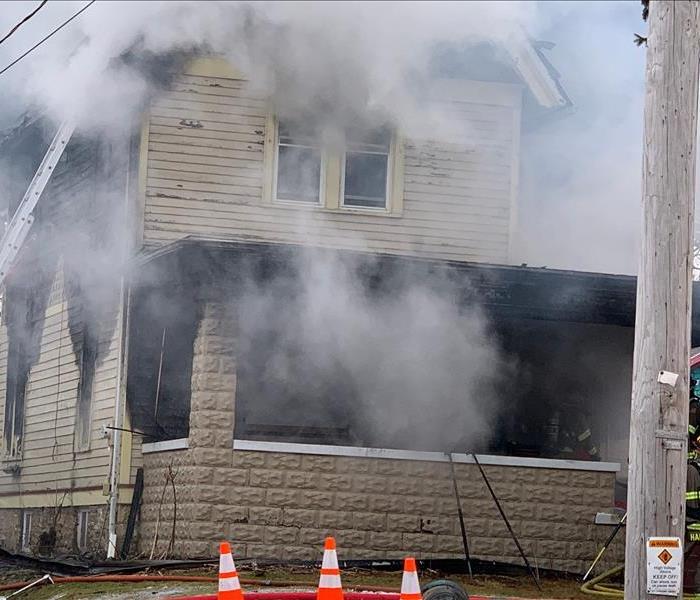 A home fire can be devastating but having a plan can help
A home fire can be devastating but having a plan can help
Having to evacuate your home because of a fire may be one of the most scary things that can happen to a homeowner. It means that you could be in incredible danger, and it might mean that your home could be completely lost. An evacuation means you have to move quickly and effectively, while making sure that nothing is forgotten. That means having a plan set out ahead of time so you are prepared to go at a moment’s notice.
Here’s everything you need to do before, during and after a fire.
Before A Fire Evacuation
Preparation is the most important part of a good evacuation plan. There are several things you do before a fire to make sure you are ready.
Disaster Relief Kit
A disaster relief kit, sometimes called a go bag, contains any essentials that you might need if you have to evacuate in a hurry. Make sure to have extra cash in there, along with extra clothing items, like sweatshirts and footwear. You should also pack emergency health information, but make sure that it is placed in a waterproof bag to keep it safe. Extras of medication should be in there, along with an extra phone charger. There are lots of sample evacuation kits on the web, so do a search to pick and choose the items that best suit your family.
Family Preparation
There are also certain things that everyone in your household should know if there is a fire. For instance, you should pick out a place for everyone to meet up at if you have to leave in a hurry. This can be in front of a neighbor’s house, for example. Make sure that everyone’s phone numbers are saved in all family members phones so that you can easily communicate if you get separated. Sometimes, a fire can affect entire neighborhoods or even municipalities. If this is the case, you should have some place you can escape to in every possible direction.
Transportation
Make sure that your car always has at least a half tank of gas. If the fire is affecting an entire area, you may need to drive a distance to get away to safety. If you do not have a car, make sure that you have a plan in place and know exactly how you will get away.
During An Evacuation
You will have to think fast while you are evacuating. It is best to already know what you want to do, so you can make the best decisions and keep everyone safe.
Communications
Do your best to keep in touch with everyone from your home at all times. If the cause of your evacuation is a wildfire, then there may be power lines down and your phones may not work. Or, you may have family members that cannot get to where you are. Always listen to the instructions from officials, such as the firefighters and police. They have more information and will know what the safest course of action is. If it is a wildfire that is affecting more than just your home, then you should also listen for emergency updates on news radio and weather stations.
Pets
Do not forget about your pets. Part of your preparation can be to have them well-trained enough to come when you call. Be sure that your pets are in a place where you can easily retrieve them.
Health and Safety
Once you are out of the building, check everyone for injuries and other issues. Emergency responders will be able to give everyone a check over as well. When it comes to being exposed to smoke, there may be unseen issues affecting you, so it is never a bad idea to head to the hospital to get checked out.
After An Evacuation
Once the fire is extinguished, you may be tempted to head back into your home to survey the damage. Do not do so until an authority has stated that it is safe, as damage to the structure may have occurred. In some cases, a home may need to be closed off until it is repaired for family members to enter safely.
The best plan of action at this point is hiring a professional fire restoration contractor like SERVPRO of Salem/Peabody/Marblehead to help you restore and rebuild your property.
Experiencing a fire in your home can be overwhelming. But, by being proactive and creating a fire evacuation plan, you are taking the first step towards preparing your family for the unexpected.
Please call SERVPRO of Salem/Peabody/Marblehead with any questions at 978.744.4545
How Smoke Can Damage Your Contents
3/17/2020 (Permalink)
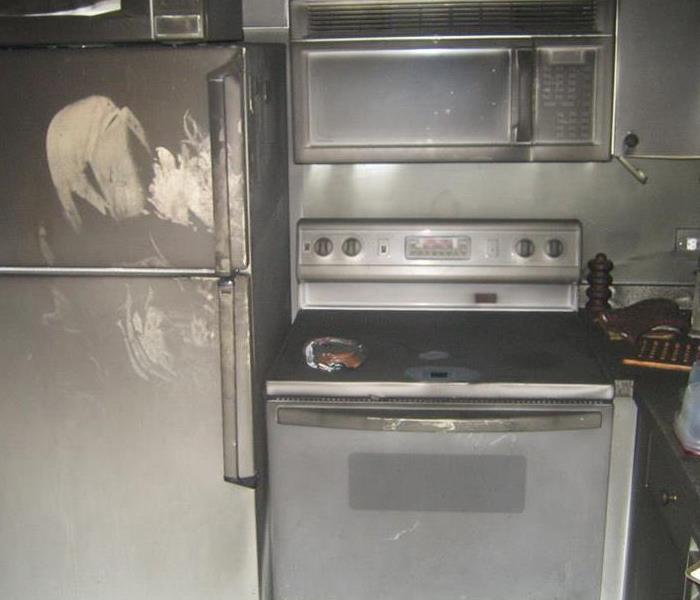 Cleaning sooty items after a fire should be left to a professional
Cleaning sooty items after a fire should be left to a professional
Fires can destroy your property and cause irreversible damage. The flames move from item to item burning everything to a crisp char. The heat produced by the flames will radiate and cause surrounding items to melt, crack and even shatter. After the flames have been put out, you are then left with smoke damage. Smoke damage left unaddressed can devastate your home and its contents, and the actual fire does not necessarily have to occur in the same room. For example, in the case of wildfires, homes and businesses have been completely ruined just from smoke while the buildings remained untouched by flames.
Even the smallest fire that has been put out relatively quickly can still cause smoke damage to your possessions. Not only that, but it can even affect the very structure of your home. This is why cleaning up smoke and soot quickly after a fire is so important. Smoke can act like an acid, and will eat away at different materials if left too long. It’s best to say that if a fire strikes your home, or if you live near an area where a wildfires has occurred, it’s crucial to act fast to reduce damages. The professionals at SERVPRO of Salem/Peabody/Marblehead can assess the damage and create a custom mitigation plan to ensure your home is completely clear of fire related damages.
What can be salvaged?
Depending on the extent of the damage and materials of the item, it may not be salvageable. Cost is a factor that should also be taken into consideration as some items will cost significantly more to salvage as it is to replace. Our team can determine what items should be cleaned, discarded or replaced.
How Does Smoke Affect Your Home?
Smoke affects various materials in different ways. Not only that, but the temperature and type of the fire will cause different variations of smoke damage throughout your home. One of the worst ways that smoke can causes damage is by sneaking into small cracks and crevices, since the particles are so fine. They can often go undetected for a long periods of time, leaving a lingering smell of smoke that can last for months. The only way to remove the smell from your home is to remove or clean affect items and to clean your homes building materials with agents designed to remove the smell.
How to Clean Smoke Damage
After a fire, your home needs to be properly and thoroughly ventilated, this will allow some smoke particles to leave your home and prevent them from settling onto other items. Remove as much debris as possible, and clean every surface area of where the damage occurred. Odor neutralizing products can help rid the building of the smell of smoke, and remove the very particles that cause the smell. Getting this done as quickly as possible reduce the chances of cross-contamination.
Upholstery and Curtains
There are special tools and techniques that are designed to remove smoke particles from upholstery such as curtains and furniture materials. A professional can best decide which tools will be most effective in cleaning those materials. Using a regular home vacuum can actually cause more damage by pushing the smoke particles and soot even deeper into the material.
Bedding and Clothing
Clothing and bedding can come into contact with smoke even when inside a closed drawer or closet. Simply washing them may be enough to remove the smell but commercial cleaning detergents may be needed depending on how strong the odor is.
Wood Furniture
Cleaning wood furniture is tricky. If you use to the wrong cleaning agent you can end up stripping the stain and varnish. Certain cleaning products can also rust metal frame, so it is important to use the right cleaning agent for each material. Our experts will have access and knowledge on the right products to use on your wood furniture.
Hardwood Floors
Unfortunately, hardwood floors are porous, meaning that smoke particles can easily get nestled in and comfortable. In some cases, it may be necessary to refinish the floor, or even replace it entirely if the damage is extensive. In the best case scenario, a simple mopping and deodorizing should do the trick.
How Fast Do You Need to Act?
Time is always of the essence when it comes to smoke damage. The sooner you act, the more likely you are to prevent permanent damage. For example, some materials, such as synthetic fibers and porous items, need intervention within minutes to be effectively saved. The components of your house, such as painted walls and flooring, need to be addressed in no more than a day or two, and in some cases hours. In addition, painted walls and wood furniture can become permanently stained if not addressed quickly. Metal surfaces can rust and corrode when smoke and soot particle are left sitting too long. The longer you leave your smoke damaged home untreated, the more extensive the damage will become and the cost to mitigate will continue to rise.
The best action you can take to mitigate the effects of smoke damage is to call SERVPRO of Salem/Peabody/Marblehead right away...978.744.4545
How to Put Out an Electrical Fire at Home
5/29/2019 (Permalink)
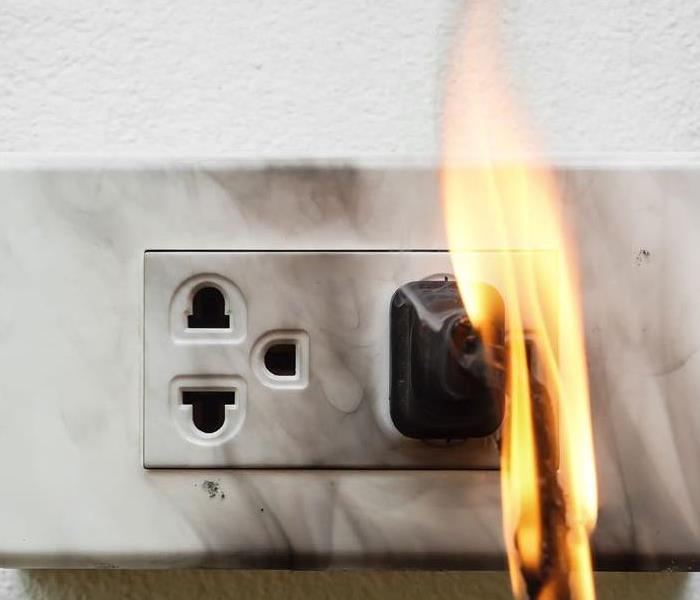 Know the dangers of an electrical fire
Know the dangers of an electrical fire
An electrical fire in the home is often a more immediate danger than a wildfire and may lead to panic. The first thing to remember is that you need to stay calm. Then, follow these steps to put out an electrical fire at home.
Step One: Call the Fire Department
The Federal Emergency Management Agency (FEMA) advises that, in the event of a fire, the first thing a homeowner should do is call the fire department.
Yes, you can put out small fires by yourself, but there’s always a chance that you will fail. If you do, you want the fire department to already be on the way, so that they can put out the fire as quickly as possible.
In fact, even if you have put out an electrical fire, there is always a chance it could re-ignite. When they arrive, the firefighters will ensure that the fire is truly out and that your home is safe.
Step Two: Assess Safety
You’ve called 911, and the fire is still raging, so take a split second to gauge your safety and your family member’s safety. If a child, senior, or someone with mobility issues is nearby the fire, evacuate them first.
Then consider if it is safe to fight the fire. According to FEMA, you need to ensure that:
- The fire is contained and still small
- You are not at risk to inhale smoke
- You have a way to escape the fire if you fail
- Your instincts tell you its okay
If you are panicking, you will not make the best decisions for your safety. It’s okay to recognize that the fire is more than you can handle, just evacuate.
Step Three: Use a Fire Extinguisher
You have to use a “C” rated fire extinguisher on electrical fires—remember C stands for “current.” Extinguishers are often rated for multiple types of fires, so an ABC extinguisher is perfect. If you have one:
- Pull the pin off
- Aim the nozzle at the bottom of the fire
- Squeeze the extinguisher’s lever
- Sweep the extinguisher back and forth across the base of the fire
What if You Don’t Have a Fire Extinguisher?
Fighting an electrical fire without a fire extinguisher is particularly dangerous because we reach for water instinctively to put out fires, but water will make an electrical fire more dangerous. If you try to use water, you may even electrocute yourself.
Instead, you first need to turn off the power to the electrical outlet or device that is on fire. It may not be safe to do this without a fire fighter’s equipment. But, if you are certain it is safe, you may flip the main breaker in the electrical outlet (it’s a larger breaker) which cuts power to the whole house.
Once the power has been cut off, the fire can be doused like a normal fire, with water or an “A” rated fire extinguisher.
If your home has been damaged by an electrical fire, all you need to do is make a single call to SERVPRO of Salem/Peabody/Marblehead. We file the claim with your insurance carrier, handle damage removal, fix damage including from smoke, clean the debris, and fully restore your home. Contact us today at 978.744.4545, we are available 24/7 to help.
An After the Fire Checklist
5/29/2019 (Permalink)
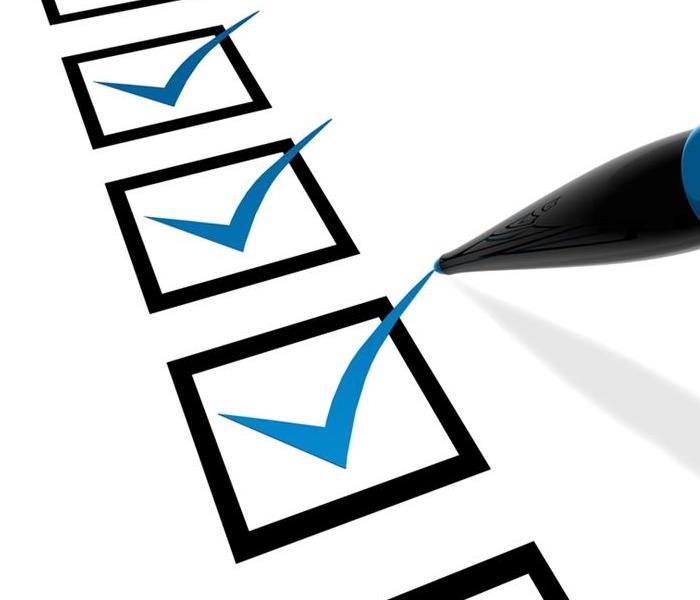 After the fire checklist
After the fire checklist
- Contact your local disaster relief service, such as The Red Cross, if you need temporary housing, food and medicines.
- If you are insured, contact your insurance company for detailed instructions on protecting the property, conducting inventory and contacting fire damage restoration companies. If you are not insured, try contacting private organizations for aid and assistance.
- Check with the fire department to make sure your residence is safe to enter. Be watchful of any structural damage caused by the fire.
- The fire department should see that utilities are either safe to use or are disconnected before they leave the site. DO NOT attempt to reconnect utilities yourself.
- Conduct an inventory of damaged property and items. Do not throwaway any damaged goods until after an inventory is made.
- Try to locate valuable documents and records. Refer to information on contacts and the replacement process inside this brochure.
- If you leave your home, contact the local police department to let them know the site will be unoccupied.
- Begin saving receipts for any money you spend related to fire loss. The receipts may be needed later by the insurance company and for verifying losses claimed on income tax.
- Notify your mortgage company of the fire.
- Check with an accountant or the Internal Revenue Service about special benefits for people recovering from fire loss.
In the unfortunate event of a fire please call SERVPRO of Salem/Peabody/Marblehead at 978.744.4545
Why Timing is Critical After a Fire Loss
5/28/2019 (Permalink)
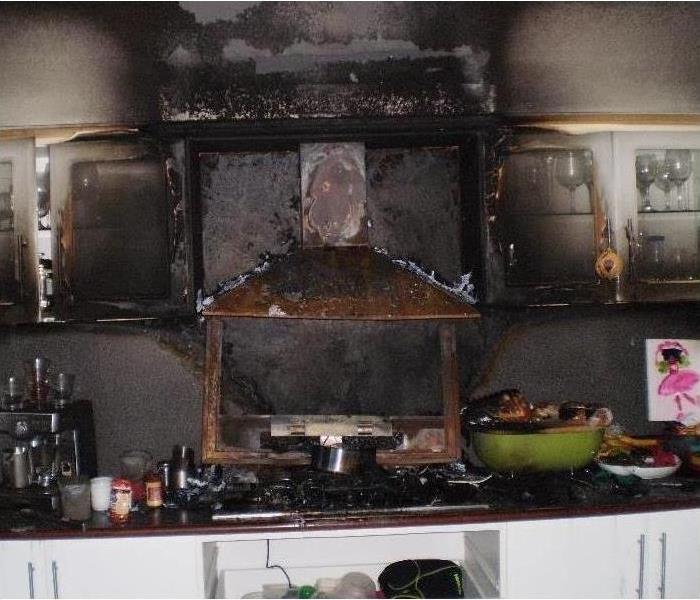 In the event of a fire it is critical to begin cleanup quickly
In the event of a fire it is critical to begin cleanup quickly
Startled by the sound of a fire alarm going off, you’re suddenly awake in the middle of the night. You rush out of bed and get yourself and your family out of the house. Once you and your family are safe, you call the fire department to come and calm the flames. After the smoke clears and the fire department leaves, you see your belongings covered in soot and water. It can be overwhelming seeing the damages that fire has caused to your home and belongings but timing is essential in fire damage restoration and you need to act fast to mitigate your home.
So, take a deep breath, and follow the steps below to get your home on track to recovery.
1. Companies You Want to Contact
Fire Restoration Service
The longer you let your home sit in soot and water damage, the further the damage. This is why it is crucial to start the fire restoration process right away. After speaking to a reputable fire restoration company like SERVPRO of Salem/Peabody/Marblehead, they will be able to develop a custom action plan to restore your home. An expert will be dispatched to your home to review the damage, get a clean up plan in place and save as much of your belongings as possible.
Insurance Company
Contact your insurance company and alert them of the situation at hand. They will be able to shed a little light on this dark situation by informing you of the next steps you need to take. With their guidance, you will be able to navigate the first initial steps of your fire damage claims. In addition, they will be able to inform you of the best practices you should take such as making a list and taking pictures of damaged items for documentation.
Utility and Lending Companies
Paying your bills and living expenses in addition to paying to having your home and belonging restored can be financially exhausting. Utility and lending companies realize this and they know the hardship a family can face in the event of disaster such as a house fire. Contact them, explain your situation, and see if they offer any hardship programs that would lower your payments or stop them completely until you get back on your feet.
Physician
Do you or a family member rely on daily medication to stay healthy? Depending on the extent of the fire damage or the origin of it, retrieving medication may not be possible. Contact your family physician and request to have your medication filled at your nearest pharmacy.
Child’s School
If you have a child in school you may want to contact the school and alert them of the situation at hand. If the fire damage deems your home unlivable you may need to stay with a family member and their home can be too far from the school. Teachers and principles are understanding of the difficulties a child and family faces in the event of a disaster and may allow them to do class work at home.
2. Disaster Relief
Disasters can devastate a family and can be especially hard if staying with family member is not an option. If this is the case, look for local disaster relief programs in your area. These agencies may be able to give you shelter, food, medication, and water until you can go back into your home.
3. Replace Important Documents
In the event of a life threatening fire, you’re probably not going to think about grabbing the safe in your house that contain important documents. Most important documents can be replaced. Here are just a few of the documents that you need to get replaced right away.
- Passport
- Driver’s license
- Birth, marriage, and death certificates
- Damaged money (you can exchange it for undamaged cash with the treasury department)
- Social security card
- Bank documents
- School records
- Tax records
- Vehicle registration
4. Start Fire Clean Up
If the fire department gave you permission to enter your home after they leave then you can start the cleaning process while you wait for the restoration company to arrive. The sooner you get the jump on this, the more likely you’ll be able to save your belongings and home. Here are some steps you can take to help begin the restoration process:
Ventilation
First and foremost you have to get the polluted air out. Open all your windows and turn on any box/floor fans that you have to circulate the air out your home. If the fire department has advised against the use of electronics for safety reasons do not use fans that use your homes electricity such as box fans.
Cleaning
Circulating air out your home does not take care of soot alone. After a fire, a smoky smell will linger in your air until soot is completely removed. Try to remove as much soot from your home as possible by sweeping. The longer your belonging are covered in soot, the more it will continue to deteriorate.
Start Fire Damage Restoration Right Away
When your home has gone through a fire, time is of the essence to save, recover and restore your belongings from fire damage. Following these steps are essential to begin the fire damages restoration process in turning your house into a home again.
Have you called a fire restoration service yet? Contact SERVPRO of Salem/Peabody/Marblehead to schedule an appointment at 978.744.4545.
Why to Board Up After a Fire Loss
5/24/2019 (Permalink)
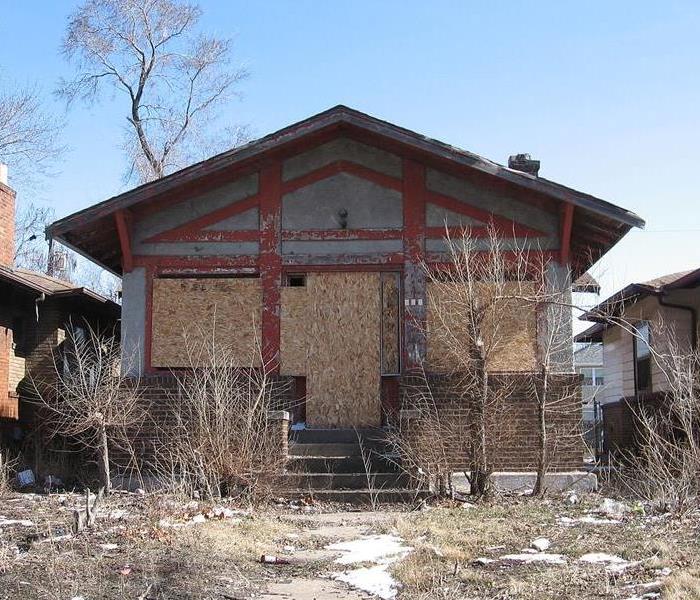 Protect your property and belongings after a fire by boarding up your structure
Protect your property and belongings after a fire by boarding up your structure
If your commercial property in Salem, Peabody, Marblehead, Swampscott or Middleton MA has experienced a fire, there are several reasons why you might want to board up structural damage or windows. In addition to keeping the external elements out of a building with fire damage, boarding up can also prevent additional losses due to looting and make the fire cleanup process easier.
Most full-service restoration specialists offer boarding-up services. Here are four reasons to board-up after a fire.
1. There is still viable stock on the premises. If products that appear viable remain in the building, you should consider boarding up. These items may require assessment and cleaning and may not be fit for sale, but having them properly processed rather than stolen can be helpful for insurance purposes.
2. You want to protect electronics and other valuables. Depending on the extent of the fire damage, you may be able to restore some electronics or other valuable property to working condition. Loss can be far more expensive than restoration or covered replacement.
3. You need to keep out the elements. If the structure of your property has sustained extensive damage, you should try to keep the elements out. Exposure to additional water, wind, or sunlight can compound the damage caused by smoke residue and soot.
4. You want to limit soot damage. It is generally a good idea to reduce foot traffic on the scene of a recent fire. When soot gets embedded into carpeting or upholstery, it can be much more difficult to restore these materials to a pre-fire condition.
Talk to restoration experts at SERVPRO of Salem/Peabody/Marblehead, about whether boarding up is a good strategy for preventing loss and limiting damage after a fire. Your major concern is likely to be how to recover from fire damage as quickly and completely as possible. Preventing looting and exposure to the elements can make fire cleanup more successful. Don’t hesitate to call us (978) 744-4545.
Fire Damage Restoration Tips
3/14/2019 (Permalink)
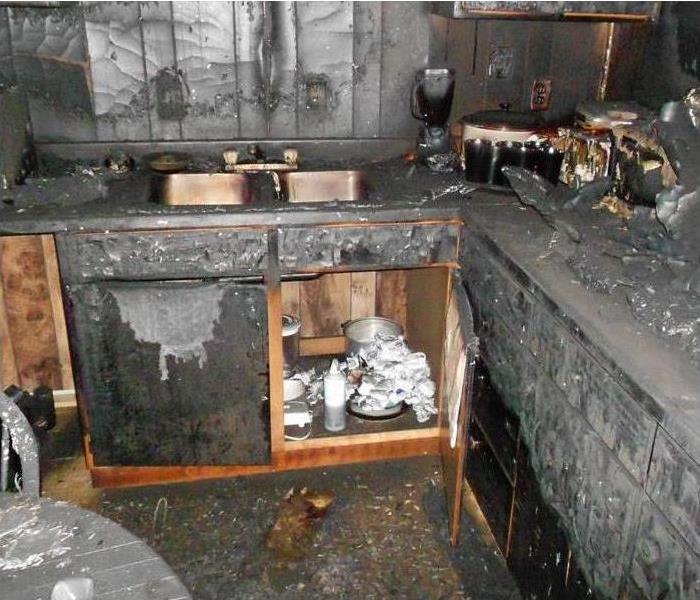 Call the experts at SERVPRO of Salem/Peabody/Marblehead for your fire loss
Call the experts at SERVPRO of Salem/Peabody/Marblehead for your fire loss
We’re not going to kid you. Fire damage restoration is tough work. People call SERVPRO of Salem/Peabody/Marblehead frequently to ask for advice on how to clean up after a fire. Here are seven of the best tips we give people who ask about fire damage restoration.
Most people can put these tips into practice. But remember that fire damage restoration takes time, work, and skill. Realistically consider whether you want to try these ideas on your own or whether you’d be better off hiring highly trained restoration specialists who will guarantee their work.
- Remove Smoke Damage
With any fire you’ll have a degree of smoke damage to your walls, wall paper, and paint. If the smoke damage is not too serious, you should be able to scrub it clean with detergents and bleach. Soot from smoke damage is greasy stuff, so always try to dust as much of it off from a surface before trying to scrub the surface clean. Often, you’ll want to repaint, but make sure all surfaces are clean and dry before you paint.
- Limit Activity & Other Simple Fire Damage Restoration Steps
Until your house is restored, limit your activity and movement in the house. This helps prevent soot particles from being embedded into upholstery and carpets. Keep people’s hands clean so you don’t further soil upholstery, walls, and woodwork. Protect your things by placing clean towels or old linens on rugs, upholstery, and carpet traffic areas. Before you clean know the best cleaning method for that particular cleaning job (one example: Clean and protect chrome with a light coating of petroleum jelly or oil.) Wash both sides of the leaves on your houseplants. Change your HVAC filter and tape double layers of cheesecloth over air registers.
Call SERVPRO of Salem/Peabody/Marblehead for Cleanup and Restoration. Call (978) 744-4545.
- Get Rid of Mold & Mildew
Firefighters are great. They save many a live and many a home. But they do introduce mold and mildew into houses when they must use water to extinguish the fire. SERVPRO of Salem/Peabody/Marblehead highly recommends you hire fire damage restoration professionals to deal with mold and mildew. Mold and mildew can cause serious health problems. It’s difficult for a nonprofessional to know for certain if he’s clean up all the areas affected by the mold and mildew. And mold and mildew can contaminate your furniture, carpets, clothing, mattresses, walls, and vents. The best thing you can do immediately is to air out every room and clean out all vents and filters.
- Replace Carpets. Clean And Dry Your Floors
Your floors and carpets end up absorbing the worst of the damage from all the water used to put out a fire. In almost every case, SERVPRO of Salem/Peabody/Marblehead recommends that you pull up any carpets that have water damage and replace them. Water can also seep underneath vinyl flooring and into the cracks in hardwood. You must address this. If you have experience with flooring, you can lift it up and clean under it. But you may want to call a professional fire damage restoration company to assist you.
- Avoid Smearing Soot Into Clothing
Cleaning smoke damage from clothing is one of the biggest jobs you’ll have after a fire. Make sure you don’t smear the greasy soot into the clothing or just throw the smoky clothes into the wash. Often times dry cleaning is the best bet, and you should ask around local dry cleaners to see if any have experience with post-fire laundry. Removing smoke odor is another issue and we’ve covered it in another blog post.
Call SERVPRO of Salem/Peabody/Marblehead for Cleanup and Restoration. Call (978) 744-4545.
- Scrub, Soak, And Cleaning Dishes
Dishes are also important items to clean thoroughly after a fire because they will be in contact with your food. Scrub all dishes well, let them soak in a solution of bleach and water (2 tablespoons of bleach per gallon) for at least 20 minutes and scrub some more for safety. When in doubt, if a dish, pot, or pan won’t come clean, cut your losses and throw it out – especially rubber or wooden dishes that absorb smoke.
Help Is Here
The team at SERVPRO of Salem/Peabody/Marblehead also has specialized training and experience in fire restoration services, natural disaster prevention, water damage, chemical cleanup, and natural disaster cleanup. Call SERVPRO of Salem/Peabody/Marblehead (978.744.4545) anytime.
The Hidden Damage of a Fire Loss
3/13/2019 (Permalink)
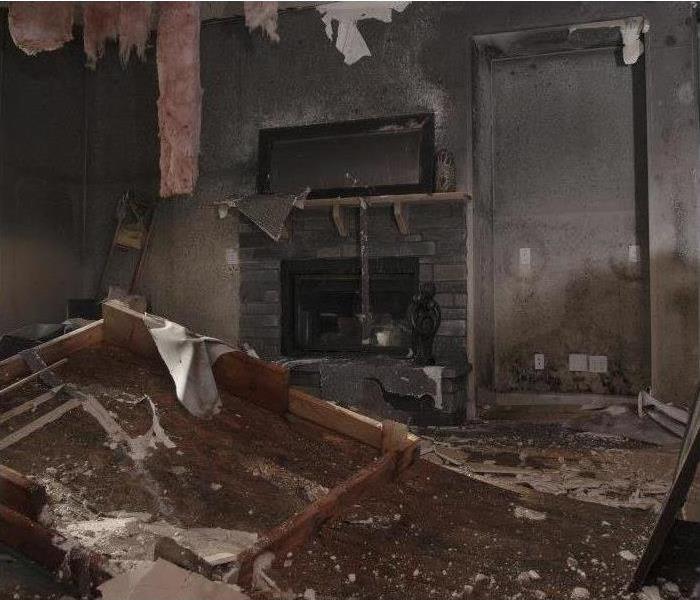 A fire can lead to soot, water and mold damage
A fire can lead to soot, water and mold damage
There’s more to fire damage than meets the eye. Fire can also cause hidden damages that may not be as easily visible. The two main culprits: smoke/soot damage and water damage. Knowing about these additional impacts on your property, and how to properly take care of them, helps ensure you’re reimbursed appropriately for your claim.
Smoke/Soot Damage
Smoke/soot damage is one of the primary hidden damages of the fire loss. Here are some things to look for to determine whether you have smoke damage:
- Stained fabric and upholstery
- Paint discoloration.
- Rust, pitting and corrosion of piping, jewelry and other metal objects
- Strong odor
- Flooring damage
You need to take care of smoke and soot damage, and pronto! This is not the time for a DIY fix in an attempt to save a few bucks on your home’s restoration after a fire.
Failure to properly deal with smoke/soot damage can cause long-term issues for your health as well as your property. Exposure to smoke/soot during fire restoration can occur via the skin and eyes, inhalation and ingestion. Because airborne soot particulate is invisible, you may unknowingly be affected. Once soot enters your bloodstream, it can cause respiratory issues, shortness of breath, bronchitis, asthma, stroke, heart attack, cancer, and even premature death. In infants, even short-term exposure to soot has been shown to have lifelong health consequences.
Because it can linger on surfaces and get inside of your electronics, appliances and other property, soot is usually a significant contributor to property damage after a fire. Plus the longer it remains, the harder it is to remove. Calling SERVPRO of Salem/Peabody/Marblehead ensures that this soot will be cleaned up properly and professionally!
Water Damage
Before dealing with the fire damage created by smoke/soot, you must first deal with the water damage. Although it’s a relief when firefighters put out the fire, pouring all that water on the flames results in water damage that can cause significant structural issues, damage to your electronic devices, appliances, furniture and important documents and, if not remedied quickly, hazardous mold growth.
Black mold can release dangerous spores into the air that can cause nausea, headaches and severe respiratory problems especially susceptible for children, the elderly and people with deficient immune systems. Pets can also be susceptible to health problems associated with the proliferation of black mold.
It’s important to take care of water damage as soon as possible so (1) you can get on with the rest of the resulting damage, and (2) to ensure hazardous mold does not grow in your property and negatively impact the health of you and your family. This is something affected homeowners cannot realistically be expected to do on their own. The only real viable solution to the dangerous effects of water damage is to call the professionals at SERVPRO of Salem/Peabody/Marblehead at 978.744.4545!
Wildfire Damage Event
3/3/2019 (Permalink)
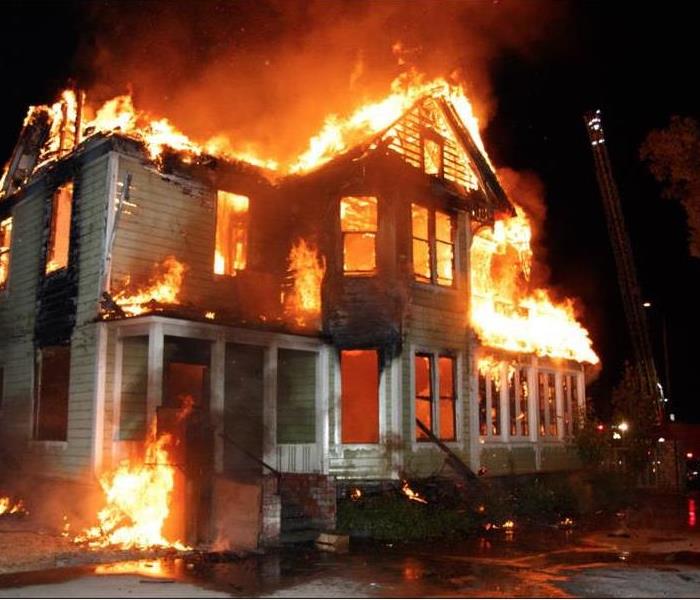 SERVPRO of Salem/Peabody/Marblehead provides fire, soot and water damage restoration service in Essex County
SERVPRO of Salem/Peabody/Marblehead provides fire, soot and water damage restoration service in Essex County
The wildfires in Southern California were devastating blazes that burned at least 96,000 acres in the Ventura area and 116,000 acres in Los Angeles County. Evacuations closed hundreds of schools and forced 200,000 people to seek safety.
Our thoughts are with those who may have been put in harms’ way during this event. In many cases, a fire can result in a total loss for a home or business, but in others it may be a partial loss, or can result in mild smoke damage. If your home or business is affected by a fire, SERVPRO of Salem/Peabody/Marblehead is Here to Help®.
About SERVPRO of Salem/Peabody/ Marblehead
SERVPRO of Salem/Peabody/Marblehead specializes in the cleanup and restoration of residential and commercial property after a fire, smoke or water damage event. Our staff is highly trained in property damage restoration. From initial and ongoing training at SERVPRO’s corporate training facility to regular IICRC-industry certification, rest assured our staff is equipped with the knowledge to restore your property.
Fire or Soot Damage? Call Us Today – We’re Ready To Help 978.744.4545
Fire Damage Restoration Process in Essex County
5/24/2018 (Permalink)
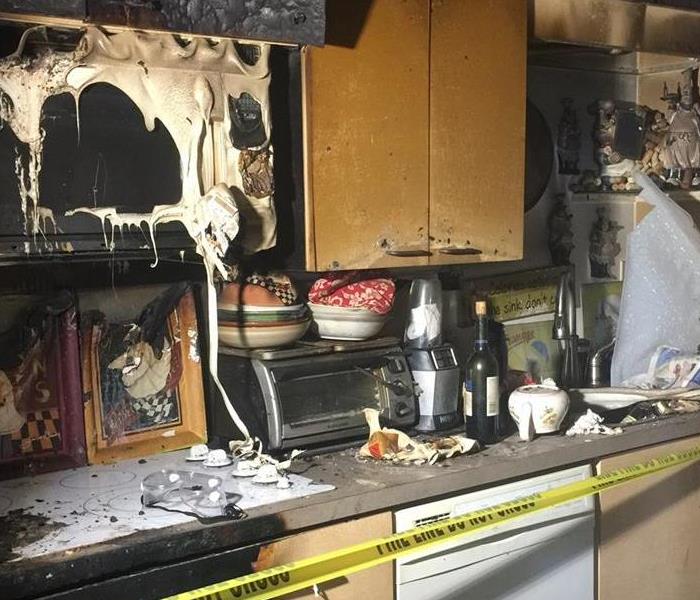 Even small fires can cause extensive damage.
Even small fires can cause extensive damage.
After the fire trucks leave, your home likely suffers from fire and smoke damage and extensive water damage from firefighting efforts. SERVPRO of Salem/Peabody/Marblehead have the specialized fire restoration training needed to restore your home to pre-fire condition.
Have Questions About Fire, Smoke, or Soot Damage? Call Today – 978.744.4545
Every fire damage event is a little different, and requires a unique solution, but the general process stays the same. The steps listed below illustrate our process for the “typical” fire damage emergency.
Step 1: Emergency Contact
The restoration process begins when you call us. Our representative will ask questions regarding the fire damage event that will help us respond immediately with the appropriate equipment and resources.
Step 2: Inspection and Fire Damage Assessment
We carefully inspect and test adjoining rooms of your property to determine the extent of the fire, smoke, and soot damage. This step is crucial to developing a plan of action.
Step 3: Immediate Board-Up and Roof-Tarp Service
Fire damage can often compromise windows, walls, and roofs. To maintain security and to protect against further damage, we can board up missing windows and walls and place tarps on damaged roofs.
Step 4: Water Removal and Drying (if water damage is present)
The water removal process begins almost immediately and removes the majority of the water. We then use dehumidifiers and air movers to remove the remaining water and complete the drying process.
Step 5: Removal of Smoke and Soot from All Surfaces
We use specialized equipment and techniques to remove smoke and soot from ceilings, walls, and other surfaces.
Step 6: Cleaning and Sanitizing
We clean, sanitize, and disinfect all of the restorable items and structures that were damaged by the fire. We use a variety of cleaning techniques to restore your belongings to pre-fire condition. We’re also trained to remove odors using industrial air scrubbers and fogging equipment.
Step 7: Restoration
Restoration is the final step—getting your home or business to its pre-fire condition. Restoration may involve minor repairs, such as replacing drywall, painting, and installing new carpet; or it may entail major repairs such as the reconstruction of various areas or rooms in a home or business.
Your Belongings and Fire Damage
5/24/2018 (Permalink)
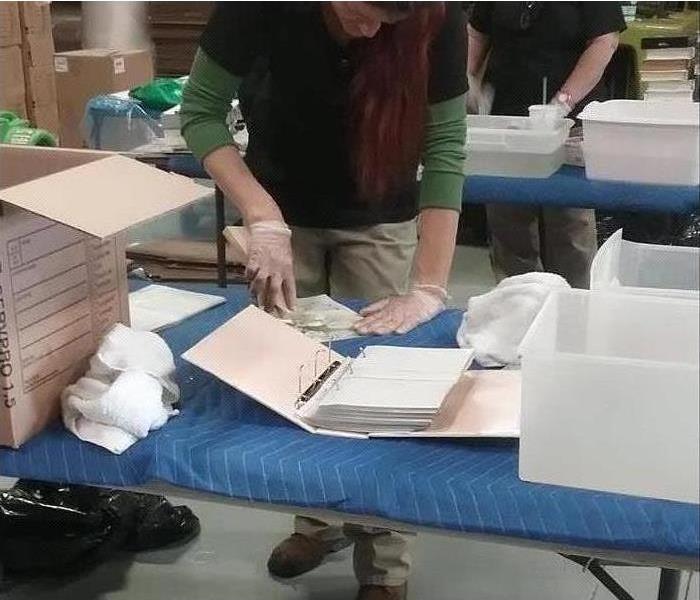 Fire damage affects your belongings too.
Fire damage affects your belongings too.
Fire damage, including smoke and soot, affects not only the structure of your house but also your belongings. SERVPRO of Salem/Peabody/Marblehead understands your family’s furniture, clothing, keepsakes, and other belongings make your house more than a structure; they make it home.
If You Have Questions or Need Help, Call Us Today – 978.744.4545
Contents Restoration
SERVPRO of Salem/ Peabody/ Marblehead specializes in restoring contents damaged by water, fire, or mold. Our expertise and “restore” versus “replace” mentality can help you save money while preserving precious keepsakes that can’t be replaced. We pretest your belongings to determine what items we can restore to pre-fire condition. We use several methods of cleaning your contents, including:
- Dry Cleaning - Used for cleaning light residues or to pre-clean prior to wet cleaning.
- Wet Cleaning - An effective cleaning method for removing moderate to heavy residues.
- Spray and Wipe -Effective for items that can’t withstand wet cleaning.
- Foam Cleaning - Used for upholstery fabrics that might shrink or bleed if wet cleaned.
- Abrasive Cleaning - Involves agitation of the surface being cleaned.
- Immersion Cleaning - Contents are dipped into a bath of the cleaning product.
Move-Outs/Pack-Outs
If your home requires extensive restoration or cleaning due to fire damage, SERVPRO of Salem/Peabody/Marblehead can conduct an organized, efficient move-out of the affected area. Move-out will provide several benefits, including:
- A quicker remodeling process
- Protecting items from potential damage
- Protecting contents from further on-site damage
When restoration is completed, we will work with you to coordinate the move-in according to your needs. The services offered upon move-in may depend on your insurance coverage.
Electronic Cleanup
Fire-damaged electronics can present a serious hazard. Do not attempt to turn on or operate any electrical device that you suspect has been damaged by fire. Smoke residues can contain acids that corrode metal surfaces. If the residues are not removed, corrosion causes electronic failure in the device. We will coordinate the restoration of your electronics, including:
- Television sets
- DVD players
- Computers
- And more
The key to restoring electronics is taking prompt action to prevent further damage. Electronics will be cleaned and inspected by a qualified electronics technician.
Document / Photograph Drying
When your valuable documents, including photographs, are damaged by water or fire, extreme caution should be taken to help ensure the fire damage does not destroy the document. Although some documents may not be restored to pre-fire damage condition, SERVPRO of Salem/Peabody/Marblehead can save a great deal and help minimize additional damage.
Depending on the type of documents and the level of fire, smoke, or soot damage, they have five options for the restoration of documents:
- Air Drying
- Dehumidification
- Freezer Drying
- Vacuum Freeze Drying
- Vacuum Thermal Drying
Contents Claim Inventory Service
When a fire emergency strikes, the damage can often feel overwhelming. We can help ease the worry and confusion during the recovery process by offering our Contents Claim Inventory Service (CCIS), which provides a detailed and accurate list of your belongings. We take a room-by-room inventory of your contents, including digital photos, and in some instances, bar coding.
Our Contents Claim Inventory Service:
- Preloss list and value of contents
- Detailed and accurate report
- Better information to settle claims quicker
- Assistance with burden of proof for claims
Peace of mind when you need it most!
Smoke and Soot Damage
5/23/2018 (Permalink)
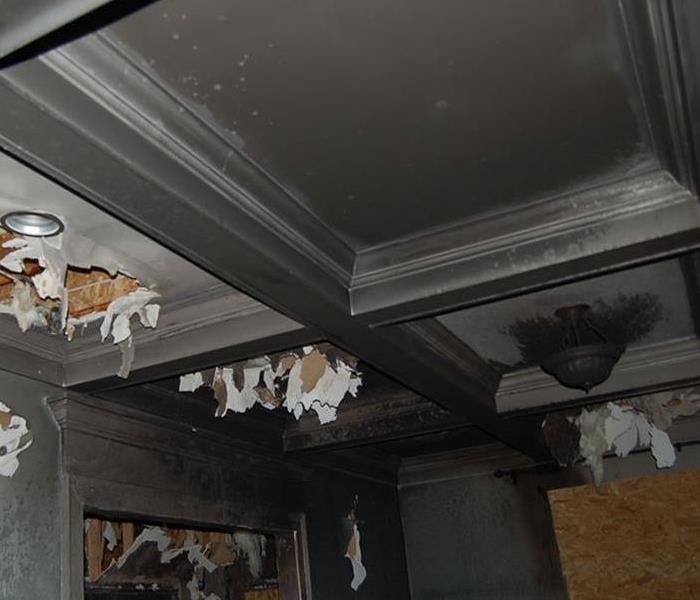 Smoke and Soot Damage Can Cause a Pervasive Odor in Your Northshore Home
Smoke and Soot Damage Can Cause a Pervasive Odor in Your Northshore Home
Smoke and soot is very invasive and can penetrate various cavities within your home, causing hidden damage and odor. Our smoke damage expertise and experience allows us to inspect and accurately assess the extent of the damage to develop a comprehensive plan of action.
Smoke and soot facts:
- Hot smoke migrates to cooler areas and upper levels of a structure.
- Smoke flows around plumbing systems, seeping through the holes used by pipes to go from floor to floor.
- The type of smoke may greatly affect the restoration process.
Different Types of Smoke
There are two different types of smoke–wet and dry. As a result, there are different types of soot residue after a fire. Before restoration begins, SERVPRO of Salem/Peabody/Marblehead will test the soot to determine which type of smoke damage occurred. The cleaning procedures will then be based on the information identified during pretesting. Here is some additional information:
Wet Smoke – Plastic and Rubber
- Low heat, smoldering, pungent odor, sticky, smeary. Smoke webs are more difficult to clean.
Dry Smoke – Paper and Wood
- Fast burning, high temperatures, heat rises therefore smoke rises.
Protein Fire Residue – Produced by evaporation of material rather than from a fire
- Virtually invisible, discolors paints and varnishes, extreme pungent odor.
Our Fire Damage Restoration Services
Since each smoke and fire damage situation is a little different, each one requires a unique solution tailored for the specific conditions. We have the equipment, expertise, and experience to restore your fire and smoke damage. We will also treat your family with empathy and respect and your property with care.
Have Questions about Fire, Smoke, or Soot Damage?
Call Us Today –978.744.4545
Commercial Fire Damage
3/1/2018 (Permalink)
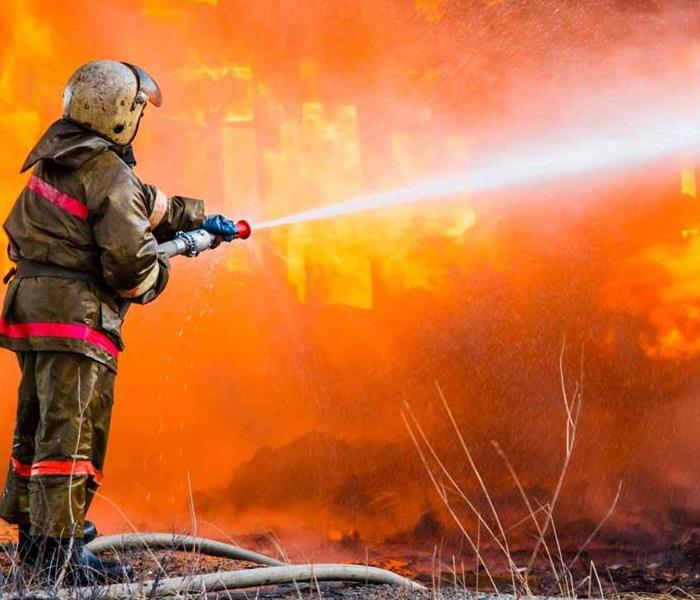 Commercial fire damage can be devastating for businesses.
Commercial fire damage can be devastating for businesses.
Fire damage is especially devastating for a business or commercial property. In addition to the fire and smoke damage, significant water damage from firefighting efforts and fire suppression systems may occur. Every hour spent restoring your business back to pre-fire condition is an hour of lost revenue and productivity. If your business experiences a fire loss, call the fire and water damage restoration experts, SERVPRO of Salem, Peabody and Marblehead and we’ll respond immediately to get you back to business.
Our staff is highly trained in property damage restoration. From initial and ongoing training at SERVPRO’s Corporate Training Facility to regular IICRC industry certifications, rest assured our staff is equipped with the knowledge to restore your property.
The Institute of Inspection Cleaning and Restoration Certification (IICRC) certifies and sets the standards for the cleaning and restoration industries. Our Professionals study IICRC standards and best practices in water restoration, fire restoration, mold remediation, carpet and upholstery cleaning, and other cleaning and restoration courses.
Call SERVPRO of Salem/Peabody/Marblehead at 978.744.4545 for any fire damage restoration needs!
Fire Damage Restoration Process
3/1/2018 (Permalink)
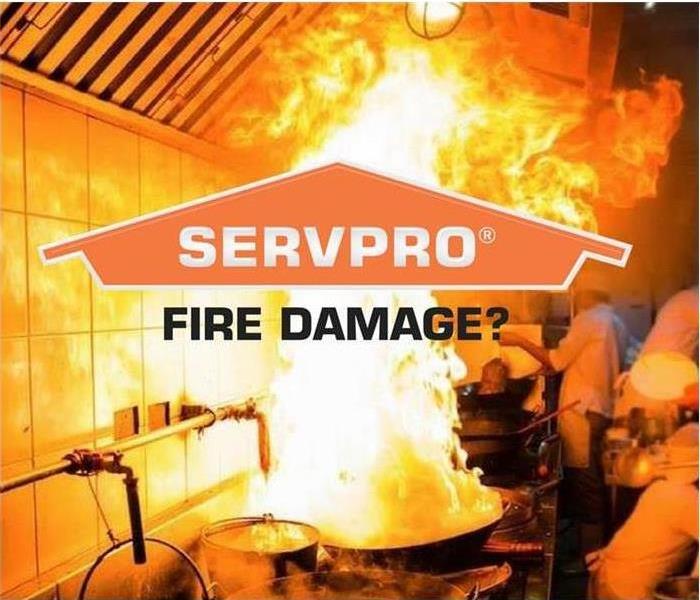 After the fire, call SERVPRO of Salem/Peabody/Marblehead!
After the fire, call SERVPRO of Salem/Peabody/Marblehead!
After the fire trucks leave, your home likely suffers from fire and smoke damage and extensive water damage from firefighting efforts. SERVPRO of Salem/Peabody/Marblehead have the specialized fire restoration training needed to restore your home to pre-fire condition.
Have Questions About Fire, Smoke, or Soot Damage? Call Today – 978.744.4545
Every fire damage event is a little different, and requires a unique solution, but the general process stays the same. The steps listed below illustrate our process for the “typical” fire damage emergency.
Step 1: Emergency Contact
The restoration process begins when you call us. Our representative will ask questions regarding the fire damage event that will help us respond immediately with the appropriate equipment and resources.
Step 2: Inspection and Fire Damage Assessment
We carefully inspect and test adjoining rooms of your property to determine the extent of the fire, smoke, and soot damage. This step is crucial to developing a plan of action.
Step 3: Immediate Board-Up and Roof-Tarp Service
Fire damage can often compromise windows, walls, and roofs. To maintain security and to protect against further damage, we can board up missing windows and walls and place tarps on damaged roofs.
Step 4: Water Removal and Drying (if water damage is present)
The water removal process begins almost immediately and removes the majority of the water. We then use dehumidifiers and air movers to remove the remaining water and complete the drying process.
Step 5: Removal of Smoke and Soot from All Surfaces
We use specialized equipment and techniques to remove smoke and soot from ceilings, walls, and other surfaces.
Step 6: Cleaning and Sanitizing
We clean, sanitize, and disinfect all of the restorable items and structures that were damaged by the fire. We use a variety of cleaning techniques to restore your belongings to pre-fire condition. We’re also trained to remove odors using industrial air scrubbers and fogging equipment.
Step 7: Restoration
Restoration is the final step—getting your home or business to its pre-fire condition. Restoration may involve minor repairs, such as replacing drywall, painting, and installing new carpet; or it may entail major repairs such as the reconstruction of various areas or rooms in a home or business.
Smoke and Soot Cleanup
2/7/2018 (Permalink)
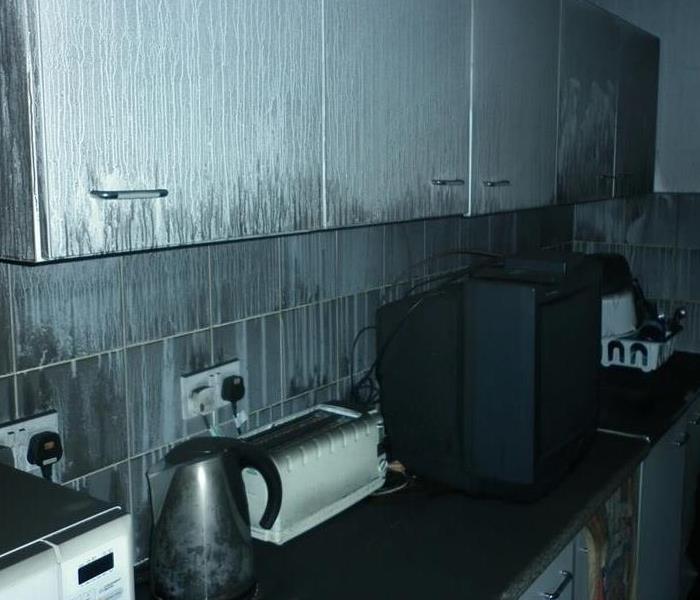 Smoke and Soot Damage Can Cause a Pervasive Odor
Smoke and Soot Damage Can Cause a Pervasive Odor
Smoke and soot is very invasive and can penetrate various cavities within your home, causing hidden damage and odor. Our smoke damage expertise and experience allows us to inspect and accurately assess the extent of the damage to develop a comprehensive plan of action.
Smoke and soot facts:
- Hot smoke migrates to cooler areas and upper levels of a structure.
- Smoke flows around plumbing systems, seeping through the holes used by pipes to go from floor to floor.
- The type of smoke may greatly affect the restoration process.
Different Types of Smoke
There are two different types of smoke–wet and dry. As a result, there are different types of soot residue after a fire. Before restoration begins, SERVPRO of Salem/Peabody/Marblehead will test the soot to determine which type of smoke damage occurred. The cleaning procedures will then be based on the information identified during pretesting. Here is some additional information:
Wet Smoke – Plastic and Rubber
- Low heat, smoldering, pungent odor, sticky, smeary. Smoke webs are more difficult to clean.
Dry Smoke – Paper and Wood
- Fast burning, high temperatures, heat rises therefore smoke rises.
Protein Fire Residue – Produced by evaporation of material rather than from a fire
- Virtually invisible, discolors paints and varnishes, extreme pungent odor.
Our Fire Damage Restoration Services
Since each smoke and fire damage situation is a little different, each one requires a unique solution tailored for the specific conditions. We have the equipment, expertise, and experience to restore your fire and smoke damage. We will also treat your family with empathy and respect and your property with care.
Have Questions about Fire, Smoke, or Soot Damage?
Call Us Today – 978.744.4545
Fire Safety
5/23/2017 (Permalink)
Fire is FAST!
There is little time! In less than 30 seconds a small flame can get completely out of control and turn into a major fire. It only takes minutes for thick black smoke to fill a house or for it to be engulfed in flames. Most deadly fires occur in the home when people are asleep. If you wake up to a fire, you won't have time to grab valuables because fire spreads too quickly and the smoke is too thick. There is only time to escape.
Fire is HOT!
Heat is more threatening than flames. A fire's heat alone can kill. Room temperatures in a fire can be 100 degrees at floor level and rise to 600 degrees at eye level. Inhaling this super-hot air will scorch your lungs. This heat can melt clothes to your skin. In five minutes, a room can get so hot that everything in it ignites at once: this is called flashover.
Fire is DARK!
Fire isn't bright, it's pitch black. Fire starts bright, but quickly produces black smoke and complete darkness. If you wake up to a fire you may be blinded, disoriented and unable to find your way around the home you've lived in for years.
Fire is DEADLY!
Smoke and toxic gases kill more people than flames do. Fire uses up the oxygen you need and produces smoke and poisonous gases that kill. Breathing even small amounts of smoke and toxic gases can make you drowsy, disoriented and short of breath. The odorless, colorless fumes can lull you into a deep sleep before the flames reach your door. You may not wake up in time to escape.
Only when we know the true nature of fire can we prepare our families and ourselves.
Create and Practice a Fire Escape Plan
In the event of a fire, remember that every second counts, so you and your family must always be prepared. Escape plans help you get out of your home quickly.
Twice each year, practice your home fire escape plan. Some tips to consider when preparing this plan include:
- Find two ways to get out of each room.
- If the primary way is blocked by fire or smoke, you will need a second way out. A secondary route might be a window onto a neighboring roof or a collapsible ladder for escape from upper story windows.
- Only purchase collapsible ladders evaluated by a nationally recognized laboratory, such as Underwriters Laboratory (UL).
- Make sure that windows are not stuck, screens can be taken out quickly, and that security bars can be properly opened.
- Practice feeling your way out of the house in the dark or with your eyes closed.
- Windows and doors with security bars must have quick release devices to allow them to be opened immediately in an emergency. Make sure everyone in the family understands and practices how to properly operate and open locked or barred doors and windows.
- Teach children not to hide from firefighters.
Smoke Alarms
A properly installed and maintained smoke alarm is the only thing in your home that can alert you and your family to a fire 24 hours a day, seven days a week. A working smoke alarm significantly increases your chances of surviving a deadly home fire.
- Install both ionization AND photoelectric smoke alarms, OR dual sensor smoke alarms, which contain both ionization and photoelectric smoke sensors
- Test batteries monthly.
- Replace batteries in battery-powered and hard-wired smoke alarms at least once a year (except non-replaceable 10-year lithium batteries)
- Install smoke alarms on every level of your home, including the basement. The U.S. Fire Administration recommends installing smoke alarms both inside and outside of sleeping areas.
- Always follow the manufacturer’s installation instructions when installing smoke alarms.
- Replace the entire smoke alarm unit every 8-10 years or according to manufacturer’s instructions.
- Never disable a smoke alarm while cooking – it can be a deadly mistake. Open a window or door and press the “hush” button, wave a towel at the alarm to clear the air, or move the entire alarm several feet away from the location.
Smoke Alarm Safety People with Access or Functional Needs
- Caregivers are encouraged to check the smoke alarms of those who are unable to do it themselves.
- Audible alarms for visually impaired people should pause with a small window of silence between each successive cycle so that they can listen to instructions or voices of others.
- Smoke alarms with a vibrating pad or flashing light are available for the hearing impaired. Contact your local fire department for information about obtaining a flashing or vibrating smoke alarm.
- Smoke alarms with a strobe light outside the home to catch the attention of neighbors, and emergency call systems for summoning help, are also available.
More Fire Safety Tips
- Sleep with your door closed.
- Only those trained in the proper use and maintenance of fire extinguishers should consider using them when appropriate. Contact your local fire department for information on training in your area and what kind to buy for your home.
- Consider installing an automatic fire sprinkler system in your residence.
- Ask your local fire department to inspect your residence for fire safety and prevention.
- Crawl low under any smoke to your exit - heavy smoke and poisonous gases collect first along the ceiling.
- When the smoke alarm sounds, get out fast. You may have only seconds to escape safely.
- If there is smoke blocking your door or first way out, use your second way out.
- Smoke is toxic. If you must escape through smoke, get low and go under the smoke to your way out.
- Before opening a door, feel the doorknob and door. If either is hot, leave the door closed and use your second way out.
- If there is smoke coming around the door, leave the door closed and use your second way out.
- If you open a door, open it slowly. Be ready to shut it quickly if heavy smoke or fire is present.
- If you can’t get to someone needing assistance, leave the home and call 9-1-1 or the fire department. Tell the emergency operator where the person is located.
- If pets are trapped inside your home, tell firefighters right away.
- If you can’t get out, close the door and cover vents and cracks around doors with cloth or tape to keep smoke out. Call 9-1-1 or your fire department. Say where you are and signal for help at the window with a light-colored cloth or a flashlight.
- If your clothes catch fire, stop, drop, and roll – stop immediately, drop to the ground, and cover your face with your hands. Roll over and over or back and forth until the fire is out. If you or someone else cannot stop, drop, and roll, smother the flames with a blanket or towel. Use cool water to treat the burn immediately for 3 to 5 minutes. Cover with a clean, dry cloth. Get medical help right away by calling 9-1-1 or the fire department.
Fire Restoration
5/23/2017 (Permalink)
After A Fire Contact SERVPRO For Fire Damage Repair and Restoration
While the amount of what you own may not reach hoarder level, after a fire has rampaged through your home, you may still be surprised at the number of items covered in soot that you now need to sort through. Without sifting through the many items, it's impossible to clean the ones that are still good. This is not a small job, and many people just throw everything away. This isn't good for the environment, or for your bank account.
Replacing everything in your North Shore home that shows signs of fire damage might seem like the easiest route, but it isn't the best course for all people. If you have very few items, and they are visibly damaged by heat instead of soot, then that might be the only course you have anyway. For those who have families and all of the many things that go along with taking care of children, you'll be aware of the memories you'll also be throwing away. This also applies to those whose children have grown and moved out, and for many others.
Cleaning up after a fire is a complicated process. Soot is also full of carcinogens and irritants. The particles can be so small that they are also very abrasive, and cleaning must be one as soon as possible. One or two unskilled people will not be able to clean at the rate needed to stop the corrosive activity of the soot. Instead, a team of skilled and highly trained individuals should be utilized to help ensure that your items are cleaned correctly.
At SERVPRO, we have experience and skills backed by training and certification in all aspects of fire damage clean up, along with repair and restoration concepts that will have your home looking, feeling, and smelling “Like it never even happened.” We won't only clean your personal belongings and furniture but also your walls, carpeting, rugs, ceilings, upholstered and non-upholstered furniture, glass and metal accents, cabinetry, doors and wooden trim, and draperies. We will bag and remove your clothing, bedding, and other linens to be washed at our facility with special cleaners that will not only remove the soot, but also the scent of the fire, and return them to you smelling fresh and clean again.
Smoke & Soot Facts
5/18/2017 (Permalink)
Smoke and soot is very invasive and can penetrate various cavities within your home, causing hidden damage and odor. Our smoke damage expertise and experience allows us to inspect and accurately assess the extent of the damage to develop a comprehensive plan of action.
Smoke and soot facts:
- Hot smoke migrates to cooler areas and upper levels of a structure.
- Smoke flows around plumbing systems, seeping through the holes used by pipes to go from floor to floor.
- The type of smoke may greatly affect the restoration process.
Different Types of Smoke
There are two different types of smoke–wet and dry. As a result, there are different types of soot residue after a fire. Before restoration begins, SERVPRO of Saginaw will test the soot to determine which type of smoke damage occurred. The cleaning procedures will then be based on the information identified during pretesting. Here is some additional information:
Wet Smoke – Plastic and Rubber
- Low heat, smoldering, pungent odor, sticky, smeary. Smoke webs are more difficult to clean.
Dry Smoke – Paper and Wood
- Fast burning, high temperatures, heat rises therefore smoke rises.
Protein Fire Residue – Produced by evaporation of material rather than from a fire
- Virtually invisible, discolors paints and varnishes, extreme pungent odor.
Our Fire Damage Restoration Services
Since each smoke and fire damage situation is a little different, each one requires a unique solution tailored for the specific conditions. We have the equipment, expertise, and experience to restore your fire and smoke damage. We will also treat your family with empathy and respect and your property with care.
Have Questions about Fire, Smoke, or Soot Damage?
Call Us Today – (978) 744-4545
SERVPRO of Salem, Peabody, Marblehead Massachusetts
Superior Company For Mold Damage Restoration
Spontaneous Combustion
2/17/2017 (Permalink)
Spontaneous Coal Combustion
Spontaneous heating of coal occurs when sufficient oxygen is available to sustain the low temperature reaction of coal with oxygen but the heat produced by the coal oxidation is not adequately dissipated by conduction or convection.
This process begins a vicious cycle where the rate of oxidation increases as the temperature increases and vice versa, or in what the study authors call a thermal runaway where a fire ensues.
Relatively common, as of January 2013, over 200 coal fires were burning in the U.S. alone. These blazes are notoriously difficult to extinguish, and one coalmine fire that could have arisen from spontaneous combustion, the Centralia Mine Fire which ignited in 1962, still burns today.
Spontaneous Hay Combustion
Counter-intuitively, hay will spontaneously combust if it gets too wet.
Dry hay (stored at 15 percent moisture or less) is safe for long-term storage. However, if the hay has become wet the quality has been permanently changed and the potential fire hazard from spontaneous combustion increased.
How does this work? this spontaneous heating is the result of biological and chemical forces:
The wet hay will first stimulate microbial growth and as these organisms grow they produce heat while drying out the surrounding surfaces of the hay for energy. More drying surfaces produces more microbial growth . . . . When the bale temperature reaches about 150F . . . heat resistant bacteria, called exothermic bacteria, start a process of chemical change that rapidly increases the temperatures to the point of spontaneous combustion.
Haystack fires are serious business. One large fire (cause unknown) in Yolo County, California burned for several days, and losses were "estimated at $2 million."
Spontaneous Linseed Oil Combustion
A common household product, linseed oil is used to protect wood and clean tools. Typically, cloth rags are soaked in the oil in order to make application easier; however, when these rags are not properly stored.
Linseed oil evaporates very rapidly causing an exothermic reach, which accelerates as the temperature of the rags increases. When the accumulated heat exceeds the rate of heat dissipation, the temperature increases and may eventually become hot enough to cause the rags to spontaneously combust.
These fires have been known to cause tremendous damage. In 1991, one of the most devastating high rise fires in the United States, in which three firefighters died, was found to have been started when workers left behind rags.
Easily prevented, "putting your used rags on a non flammable surface to dry, in an open area like your driveway. . . . Just lay them out flat . . . Once they are dry, you can clean them up."
Spontaneous Human Combustion
In the typical case where spontaneous human combustion (SHC) is suspected, a body is found that appears to have been burned from the inside out; and, while there is tremendous burn damage to the person's torso, her extremities (hands, feet and limbs), as well as her surroundings, are not touched by the fire.
Proponents of SHC will often point to any of several potential internal causes for the blaze. Methane in the intestines (think farts) is often suggested as a fuel source, and some believe naturally occurring enzymes could be the catalyst. Static electricity has also been named as a potential culprit.
These true believers point to stories like that of an Oklahoma man whose horribly burned body was found in his kitchen, surrounded by items and furniture that was not damaged. The 65-year-old victim was known to be a heavy smoker and drinker. Some proponents point out that alcohol is also flammable, but argue that its action had to be internal, or else other flammable items in the home would have burned.
Naysayers take this same evidence and use it to disprove the theory. They claim that these deaths occur because the human body has acted like an inside-out candle
A candle is composed of a wick on the inside surrounded by a wax made of flammable fatty acids. The wax ignites the wick and keeps it burning. In the human body, the body fat acts as the flammable substance, and the victim's clothing or hair acts as the wick. As the fat melts from the heat, it soaks into the clothing and acts as a wax-like substance to keep the wick burning slowly. Scientists say this is why victims' bodies are destroyed yet their surroundings are barely burned.
So, regarding the Oklahoma man, naysayers would argue that he likely passed out, from drinking or otherwise, and a hot ash from his cigarette, or another external source, ignited the fire. As fire tends to burn upwards, rather than out, as long as nothing extremely flammable is around the man, we simply have a human candle that burns away leaving surrounding areas seemingly untouched.
Recent scholarship appears to have discovered the fuel, if not the ignition mechanism. In a study performed by Cambridge research biologist, Brian J. Ford, it was determined that acetone, a naturally occurring substance in the body, could cause the injuries seen with suspected SHC victims.
Acetone is characterized by Prof. Ford as "one flammable constituent in the body that can greatly increase in concentration," and this happens when a body is in a state of ketosis. Potential causes of ketosis include certain diets, diabetes, teething and even alcoholism. Regardless of its source, acetone is highly flammable.
In his experiment, Prof. Ford
Marinated pork tissue in acetone [then used it] to make scale models of humans, which we clothed and set alight. They burned to ash within half an hour
Ford concluded that "for the first time a feasible cause of human combustion has been experimentally demonstrated."
8 Candle Safety Tips
2/17/2017 (Permalink)
Candles are the very soul of romance. Their flickering light gives a warmth to everything around them. They figure in song and story and cover the tops of birthday cakes and grace mantles. They are everywhere. Almost every house has at least a few buried somewhere, whether for birthdays, the love of the scent, or even as a decor accent. Candles are so commonplace that people forget just how dangerous they can be. Candles are not just sources of light, they are open flames. Every fire needs to be treated with caution, and candles are no different. That is why every member of every household should know and follow eight basic safety tips every time they light a candle.
How a Candle Works
Candles generate both light and heat through the simple process of combustion. One of the most important things to remember is that even though it is the wick that supports the flame, the wax is what burns. What happens is that when the wick is first lit, it melts the wax.. Because the wick is absorbent, it draws some of the molten wax up to the flame, where it vaporizes and then ignites. It is this burning wax vapor that produces most of the light and heat, reaching up to 2,550 degrees Fahrenheit at its hottest point. This is what makes a candle wick last so long. It simply carries the molten wax, serving as a kind of fuel line. Some of the molten wax does drip down the side, but that is more a measure of inefficiency than anything else. Once the wax is gone, the candle can no longer be used.
8 Candle Safety Tips
Candle safety is all about remembering that a candle is an open flame and treating it accordingly. As long as the candle is treated with the respect it deserves, problems are unlikely. If people in the home are going to be careless with candles, they are quite literally playing with fire. One simple way to ensure safety is to remember the following eight tips.
Tip 1: Always Use a Candle Snuffer
Some people like to blow a candle out, but this can send wax and possibly embers flying. Using water to put out a candle is even worse. The mixture of cold water and hot wax can send the wax splattering everywhere, possibly leading to burns. The cold water can also be dangerous to glass candle holders, as the sudden drop in temperature can cause the glass to crack, potentially spilling hot wax everywhere. A candle snufferstarves the flame of oxygen, ensuring that it goes out gently, without giving the wax a chance to spatter. It is the safest way to douse a candle without worrying about spatter or burning one's fingers on the wick.
Tip 2: Never Leave a Candle Unattended
It is a simple rule for anything that burns; fires should never be left unattended. This is particularly true of candles, as some can easily tip over, greatly increasing the chance of fire. The presence of pets just adds to the danger. Seconds matter when it comes to fire, and unattended fires mean that there is not one present to take action in the most important seconds. It simply is not worth the risk.
Tip 3: Do Not Rely on Candles When the Power Goes Out
It is a common misconception that because people often used candles for light before electricity they should be the first thing to turn to for light when the power goes out. Sadly, this is not the case. Candles were only one of many lighting options used before the proliferation of the electric light, and oil lamps were much more common. In most cases, a flashlight is a much better and safer option when the power is out than a candle. This is especially important when rummaging in a closet, as the flame can catch clothing on fire, turning the minor inconvenience of a power outage into a major disaster.
Tip 4: Always Use a Proper Candle Holder
It is a bad idea to simply stick a candle in a drop of hot wax in the middle of a plate or saucer instead of using a candle holder.. It simply is not safe. A proper candle holder includes both a socket to hold the candle and a well for the drippings. Many also have a ring or other handle in case the candle has to be moved. Candle holders should also be heat resistant so that they can protect the surfaces they rest on, such as tables that could otherwise be scorched from the heat of the candle or wax drippings. It is also important to make sure the holders are set on flat, stable surfaces to minimize the chance they will tip over.
Tip 5: Keep Burning Candles 3 Inches Apart
When arranging candles, it is important that they not be placed too close together to prevent the heat from one candle melting another. This can cause a serious problem because, even if the heat is not sufficient to melt the other candle completely, it can often be more than enough to soften the wax so that the candle can bend, with possibly disastrous results.
Tip 6: Do Not Burn a Candle Down to Nothing
For those who consider themselves frugal in all things, it can be tempting to get the most out of a candle by burning it all the way down to nothingness. While this does ensure the longest burn, that does not mean that it is a good idea. For safety's sake it is better to extinguish the candles once they reach about 2 inches from the bottom or 1/2 inch if the candle is entirely enclosed in a container. This ensures that the wick remains vertical and that the burn stays under control the whole time.
Tip 7: Never Use Candles if Someone in the Home Uses Oxygen
Fire thrives on oxygen, and using candles in a household where someone uses oxygen is courting disaster. The additional oxygen accelerates combustion and turns almost any spark into a runaway fire. While oxygen tanks are enclosed and can be kept far away from candle flames, it simply is not worth the risk to burn a candle anywhere in the vicinity of oxygen.
Tip 8: Keep Burning Candles Away From Drafts
While candles do require ventilation so that they do not exhaust the oxygen in the room, they should also be kept away from drafts in order to ensure a controlled burn. Strong drafts can not only lead to smoke and soot being produced by the candle but also fires if the draft is strong enough. With sufficient air movement, either the candle can be blown over or something light and combustible can be blown into it. Even if the draft is not strong enough for that, it can still lead to uneven burning that shortens the useful life of the candle.
Where to Buy Candles
Candles are available almost anywhere. Consumers who prefer to shop locally can find candles in hobby centers, corner stores, grocery stores, home stores, and major brick-and-mortar chains. People have been selling candles for centuries, and it should be no surprise that they have become ubiquitous. Those who prefer to shop from the comfort of home can find candles at most Internet retailers, major and many minor, as well as online auction sites like eBay.
Buying Candles on eBay
If you prefer to search, just enter the terms you want in the Search box on the main page, and watch the results appear. There really is a candle for every need, and you can use the filters in the sidebar on the results page to narrow your search to show just the candles you want. Once you have the list properly narrowed down, you can use the sort function to arrange order in which the listings are displayed to best fit your priorities, whether that be price or seller distance. The seller profile page is also a great resource to ensure you do business with a reputable individual. You can see the seller's feedback, location, and which shipping company they use. It only takes a few clicks to find both the candles and the seller you want.
Conclusion
Candles can add to the ambiance of any room, but they can also add to the danger. Users should never forget that every time they light a candle they are setting light to an open flame. Even so, the risk of that open flame can be greatly reduced by anyone willing to follow just a few simple tips. In almost every case, the key to these tips is to keep the candle flame under control and away from anything flammable. Keeping the candle vertical also helps, as it performs both functions, helping maintain a safe distance from anything flammable and combustion under control. Ventilation is also important, as both too much and too little airflow around the candle can cause problems. But by following these eight simple tips, it is easy to enjoy the ambiance in safety.
After A Fire Checklist
2/2/2017 (Permalink)
After a Fire Checklist The following checklist serves as a quick reference and guide for you to follow after a fire strikes.
- Contact your local disaster relief service, such as The Red Cross, if you need temporary housing, food and medicines.
- If you are insured, contact your insurance company for detailed instructions on protecting the property, conducting inventory and contacting fire damage restoration companies. If you are not insured, try contacting private organizations for aid and assistance.
- Check with the fire department to make sure your residence is safe to enter. Be watchful of any structural damage caused by the fire.
- The fire department should see that utilities are either safe to use or are disconnected before they leave the site. DO NOT attempt to reconnect utilities yourself.
- Conduct an inventory of damaged property and items. Do not throw away any damaged goods until after an inventory is made.
- Try to locate valuable documents and records. Refer to information on contacts and the replacement process inside this brochure.
- If you leave your home, contact the local police department to let them know the site will be unoccupied.
- Begin saving receipts for any money you spend related to fire loss. The receipts may be needed later by the insurance company and for verifying losses claimed on income tax.
- Notify your mortgage company of the fire.
- Check with an accountant or the Internal Revenue Service about special benefits for people recovering from fire loss. Source: United States Fire Administration.
Types Of Smoke
7/18/2016 (Permalink)
Types of Smoke:
- Wet Smoke (caused by plastics & rubber)
o Low heat, smoldering, pungent odor, sticky, smeary. Usually produces smoke webs that are more difficult to clean.
- Dry Smoke (caused by paper & wood)
o Fast burning, high temperatures, heat rises therefore the smoke rises.
- Protein Fire Residue (produced by evaporation of material, such as animal fat, rather than from a fire)
o Virtually invisible, discolors paints and varnishes, extreme pungent odor.
- Fuel Oil Soot (furnace puff backs)
o A “puff back” is a misfiring in the furnace that can send soot throughout your home, covering drapes, bedding, furniture, cabinets, walls, and everything in between. While “puff backs” can create havoc for the homeowner, SERVPRO® of Salem, Peabody, Marblehead can, in most cases, restore the contents and structure quickly.
- Other Types (tear gas, fingerprint powder, and fire extinguisher residue)
SERVPRO® of Salem, Peabody, Marblehead professionals are trained to handle your toughest losses.
Before you risk doing further damage by attempting to clean up the damage yourself, call the smoke damage cleanup and restoration professionals:
SERVPRO® of Salem, Peabody, Marblehead at 978-744-4545
24 hours per day / 7 days per week
 When your MIddleton home has a fire-damaging meltdown--Call SERVPRO to restore your property and your peace of mind. Here to Help®
When your MIddleton home has a fire-damaging meltdown--Call SERVPRO to restore your property and your peace of mind. Here to Help®






 24/7 Emergency Service
24/7 Emergency Service




































